#new york labor law posters
Photo

United States Department of Labor poster, 2010
Mary G. Harris Jones (1837 (baptized) – November 30, 1930), known as Mother Jones from 1897 onwards, was an Irish-born American schoolteacher and dressmaker who became a prominent union organizer, community organizer, and activist. She helped coordinate major strikes and co-founded the Industrial Workers of the World.
After Jones's husband and four children all died of yellow fever in 1867 and her dress shop was destroyed in the Great Chicago Fire of 1871, she became an organizer for the Knights of Labor and the United Mine Workers union. In 1902, she was called "the most dangerous woman in America" for her success in organizing mine workers and their families against the mine owners.In 1903, to protest the lax enforcement of the child labor laws in the Pennsylvania mines and silk mills, she organized a children's march from Philadelphia to the home of President Theodore Roosevelt in New York.
#Mary G. Harris Jones#Mother Jones#women in history#women in union#XIX century#XX century#united states department of labor#labor#labor union#poster#people#art#arte#xxi century
6 notes
·
View notes
Link
This report was written by Andrew Perez, Julia Rock and David Sirota
Draft legislation circulating in the U.S. Senate would shield employers and health care industry executives from legal consequences when their business decisions injure or kill workers, customers and patients during the COVID-19 outbreak.
The unprecedented proposal to gut legal protections — which is being depicted as moderate compromise legislation and potentially attached to badly-needed state and local aid — follows a Harvard study showing a surge in worker COVID deaths following their requests for government regulators’ help.
The Huffington Post reported on Monday that Democratic Sen. Joe Manchin is joining GOP senators in backing corporate immunity legislation. A draft of the legislative language obtained by The Daily Poster includes provisions that would:
Shield companies from all coronavirus-related actions retroactively — for at least one year, or until the pandemic is over — except in cases of “gross negligence.” Most coronavirus-related lawsuits would be forced into federal courts, which are considered more friendly to business interests.
Restrict the enforcement of longstanding laws such as the Fair Labor Standards Act of 1938, the Occupational Safety and Health Act of 1970 and the Civil Rights Act of 1964 when companies say they are attempting to comply with governments’ coronavirus guidance.
Empower the United States Attorney General to deem coronavirus-related lawsuits from workers, customers and attorneys “meritless” and then file civil actions against them as retribution. In order to “vindicate the public interest,” courts would be allowed to fine respondents up to $50,000.
Shield health care executives from lawsuits through language copied word-for-word from a statute passed in New York by Democratic Gov. Andrew Cuomo amid a spate of COVID deaths in that state’s nursing homes.
“Substantially Immunizing Businesses From Risky Conduct”
The legislation defines gross negligence as “a conscious, voluntary act or omission in reckless disregard of (A) a legal duty; (B) the consequences to another party; and (C) applicable government standards and guidance.”
“We are wiping out the laws of negligence,” said Michael Duff, a former National Labor Relations Board official who is now a professor at the University of Wyoming College of Law. “As a practical matter, we are substantially immunizing businesses from risky conduct.”
“What they want to do in this bill is throw every lawsuit out before it conceivably gets to a jury,” he said. “It means that a judge has the authority to dismiss a case right upfront. Because there’s no way that plaintiffs are going to be able to meet this standard — gross negligence.”
He added that the provision empowering the Attorney General to punish plaintiffs “is a bald-faced threat of reprisal for having the temerity to pursue rights.”
“That Is Not A Negotiation — That Is A Collapse”
Lawmakers released a separate $748 billion COVID-related proposal that includes expanded unemployment benefits, an extension of the Paycheck Protection Program, and funding for COVID-19 testing and vaccine distribution. It would also reauthorize a CARES Act provision allowing the government to funnel money to out-of-work defense contractors.
The latter package did not include a new round of $1,200 stimulus checks sought by Vermont Independent Sen. Bernie Sanders and Sen. Josh Hawley, R-Mo. Only $188 billion of the proposal is new stimulus money — the other $560 billion is repurposed from the CARES Act, passed this spring.
Sanders criticized Democrats for their handling of coronavirus relief talks. “What kind of negotiation is it when you go from $3.4 trillion to $188 billion in new money?” he said. That is not a negotiation. That is a collapse.”
According to Politico, Reps. Josh Gottheimer, D-N.J., and Tom Reed, R-N.Y., the co-chairs of the House Problem Solvers Caucus, are pushing to combine the two bills into one $908 billion proposal.
#senate#covid19#fuck covid#bernie sanders#capitalist hell#capitalism#anti capitalism#covid legislation#class war#class warfare#OSHA#law#covid law#covid cases#burn down the senate#burn down washington
25 notes
·
View notes
Text
Witch!Kurt #43: Reconnoiter
Burt Hummel eagerly offered his home as the coven’s headquarters when Kurt called him to explain that they were ready to move forward.
Though Kurt had made the call with the intention of convincing his family to leave town for a few days, just to be safe, his father insisted.
“Are you kidding? I was one of the people who fell hardest for Blaine’s fake charm and let that punk sink his claws into my son!” Burt protested hotly when Kurt attempted to tell him that leaving would be safer. “I didn’t listen when my step-son tried to tell me that he thought it was hinky that neither he or Carole were invited to that big hoohaw at Dalton, and that he didn’t understand why you’d agreed to marry someone you weren’t sure you trusted enough to date anymore. I didn’t pay any attention when kids you knew and loved started disappearing, dying, or becoming walking store mannequins. Blaine attacked this town, a town I’ve lived in and loved all my life, and he attacked my family. I’m damned well going to stick this one out with you, Kurt. End of discussion.”
“Dad, this…”
Burt cut him off. “No buts. This is your fight? That makes it my fight. And even if all I’m really equipped to do in this whole witchcraft game is supply house room to the band, I’d still rather do that than to be shut out and left wondering what’s happening. Besides, you’ve all warded this place strongly enough to make Fort Knox look like a piggy bank. Where would I possibly be safer?”
Kurt, remembering how badly Blaine’s magically charged charms had shaken the once solid father-son relationship, not to mention the harm he’d done to Finn, and by extension Carole, could not find it in his heart to argue. His coven had the power to move Burt Hummel out of harm’s way, whether he wanted to go or not, but he and his dad had worked hard these last few months to build and solidify that old bond into something even stronger, to respect and be honest with one another. Kurt had to trust that his dad could take care of himself, just as Burt was doing for him.
A vague part of him feeling amusement over his father’s continued habit of referring to his coven as ‘the band’, Kurt said in a deliberately meek tone, “Dad, I was just going to say that this is really generous of you, and that I think you’re right. I don’t think you’re to blame for what happened, but you do have a stake in this and if it makes you feel better to have us at the house, and to be in on the planning with us, then we’ll come. Thank you.”
“Oh,” Burt said, the righteous indignation fading to sheepish humor as he said, “Sorry. You’re welcome. Uh, when do you think you’ll be here?”
“Next week. Spring Break got delayed after all those storms shut everything down over the winter,” Kurt explained. “We decided that would be the best time. Lima high schools should have already had their Spring Break, so now would be the perfect time to look them over.”
And while this was not how most college students would want to spend their break, converging on a quiet little town in the middle of Ohio to play the role of magical exterminators, not one person in Kurt’s coven had balked at his suggestion. On the contrary, they had all agreed with enthusiasm that surprised him a little. Even with all the help they had given over the past six months, their support still occasionally caught him off guard.
“Great, we’ll be ready for you,” Burt said, sounding far more pleased than most men would at the prospect of having their home overrun by seven additional ‘kids’ and two more cat people.
~*~*~*~*~
A week later, having all arranged to miss a few days of work and other activities, the coven arrived in Lima, backpacks, duffels, sleeping bags, and suitcases in hand. Even those who had the option of staying somewhere less crowded had packed like they really were headed out on vacation somewhere. It made Kurt smile to hear them arguing over who would stay where, and what things they might do while in Ohio.
“Carole and I discussed it with the boys and we decided we’d put most of you down in the basement,” Burt Hummel said above the din of many chattering voices, bringing them to a halt as everyone looked at him. “It’s all finished up, with lights and carpeting and plenty of room.”
The family had spent the past few months renovating the previously unfinished space into a rec room, but then Burt and Carole had discussed it and decided instead to turn it into a new living space for Fam. The basement was large and well insulated, but it had been lacking the comforts of carpet, good lighting, and the finishing of an adjunct room that had been piped by the previous owner for an additional bathroom but never completed. Finishing it up had been a labor of love, and a way for Finn and Sam to feel useful and to have some control in their lives again, as well as a chance to bond anew with the grateful parents.
Kurt had given his Dad the idea for the project during a Skype, pointing out that Sam had once been quite a good handy-man, and knowing how much he himself had loved having the basement of the first Hummel home for his own during high school. It was neither safe nor practical for Sam and Finn to be out on their own for now, but at 22 years of age it also wasn’t fair for them to be living in a small upstairs bedroom under Burt and Carole’s very noses.
“You finished it?” he said, perking up with interest. “Nobody told me! How did it come out? What kind of carpet did you end up choosing? Did you use the privacy screens I suggested to block the laundry area off from the bedroom, or did you actually have to build a new wall?”
Grinning at his son’s eager questions, Burt gave into his impulse to give the bright-eyed young man another hug. No matter how good Kurt’s adult life in New York was, Burt never quite got over missing his little boy. And when Kurt was like this, clasping his hands and bouncing with enthusiasm, he became that little boy again. “Why don’t you come see for yourself?” he asked jovially, leading the way to a closed door next to the kitchen.
Burt, Kurt, Adam, and the rest of the curious coven trooped down a set of wide wooden steps, the latter making appropriate noises of appreciation when Burt flicked a wall switch and led them into a well lit space with a pull-out sofa bed, a couple of comfy looking lounge chairs, and a TV. The floor had been covered in thick, dark blue Berber carpeting, with the center living area covered with an additional wide area rug of tightly woven black and gray that matched the contrasting black and gray walls. It was a surprisingly sophisticated look for something that was to belong, in part, to Finn Hudson.
“This is very chic,” Adam said, not quite able to disguise the astonishment in his voice that told Kurt he had been thinking along the same lines. Adam did not know his new brothers-in-law (For he had come to think of Sam Evans as another of Kurt’s brothers.) very well yet, but he had already noted a distinct leaning toward ‘frat boy’ in both of them.
“It is,” Kurt agreed, looking around with interest and peeping into the laundry area, which had indeed been separated from the rest of the basement by a newly added wall and floored with tightly packed ceramic tiles.
The new laundry room had a door that made it accessible through the garage, so people would not be required to tromp through Fam’s private space to wash their clothes. Behind the laundry area lay the now-finished bathroom, and Kurt gave it an approving nod. They had sacrificed a little bit of bedroom space to expand the room, giving it a row of handsome wooden cabinets beneath the new sink, a glass-paneled shower, tile flooring, a new toilet and several shelves along the wall that were liberally stacked with towels, soaps, and various other hygiene products. There was a large cabinet mirror over the sink, a laundry hamper next to the shower, and even a cute little black iron rack with several reading selections next to the toilet.
Kurt noted that final addition with amusement, recalling his brother’s habit, a very annoying one when they had been sharing a bathroom, of spending what felt like ages reading through magazines while conducting his ‘morning business’. Undoubtedly, this touch had been Carole’s.
“This looks amazing. I have to admit, I was expecting a lot of beige, and way more football and rock posters on the walls,” he said with a smile.
“Maybe we’ll add some,” said Finn, coming downstairs to join the others and giving Kurt a friendly embrace. “We still have to move my old drum-kit out of the garage and put it in here. Mom couldn’t bear to give it away after I died. And Sam wants to put a rack on one wall for his guitars. Burt brought a contractor buddy of his in here to put an extra layer of sound-proofing in the walls before they were sealed and painted.”
Burt raised an eyebrow at his son and said, “George Moore. Same friend I got to help me sound proof our old basement into someplace you could sing your face off at five o’clock every morning, while you were trying on every outfit you owned and dolling up your skin and hair for two hours before school.”
Everyone laughed at Kurt’s acknowledging blush. Maybe Finn had not been the only one with irritating habits in those days.
Sam took over the shared body to say, “We’re gonna put a boss stereo system along that back wall by the dressers, and maybe a computer desk, and I want some bookcases with a reading lamp.”
The switch in control between one man and the other was also a lot faster and easier now than it had been when they were initially merged, and all those listening were interested to realize that they had no difficulty in knowing who was speaking.
Kurt looked at him curiously. He never remembered either of these two having a particular interest in books before.
Reading the question in his eyes correctly, Sam shrugged. “I always liked stories, but I used to feel like it was too much of a bother to decipher all the text to read much. Got a lot of Graphic novels and audio books instead. I mean, I could do it, but it felt too much like homework, y’know?” At Kurt’s nod, he grinned. “We discovered a side benefit of sharing a body. Whatever rewiring of our brains that was required to live this way had some perks. I still have dyslexia, but when Finn is in control I can sort of read through his eyes, and the letters don’t get all messed up. Kind of weird, but it works!”
Finn chimed in. “It makes me like reading for fun a lot more, knowing that I can help Sam do it. English Lit was pretty much the only school subject I always got perfect grades in, so it’s no big deal. Oh, and we’ve discovered that if we concentrate hard, we can do this.”
He lifted his hands, scrunched his brow, and made a shoving motion with his palms out, resulting in the chair he was looking at scooting a couple of feet away.
The witches in the room looked at him with slack-jawed surprise. Sam was a Standard, and since it was his body that Finn’s mind and soul were sharing, no one had expected Finn’s latent magic to translate to this new existence. Sam jumped back in. “This part works no matter who’s in control.”
In demonstration, he stuck his tongue out slightly and frowned hard at the remote control on the little coffee table they had set up next to the couch. It twitched a few inches closer.
“How is that possible?” Kurt asked, looking around the group.
Brittany stepped forward, cocking her head like a curious puppy as she narrowed her eyes and looked Fam over with Sight. “They’re merging,” she said in a vaguely detached tone. “Still Finn and Sam, but Fam is becoming real. At first you were in sort of a disassociative identity situation, with one body but two personalities, and one person had to be fully in control to do anything. Now you’ve adapted to be more like conjoined twins instead. Individual people who happen to share one body, and that body is starting to adapt to both your abilities. Magic comes from the soul, as much as the body. After all, there are plenty of Standards with magical parents, and plenty of witches with no magic in their family trees. Where did they get that if it wasn’t just a natural facet of who they are?”
“So that means even though I’m in a different body, I’m still me, and I’m still a witch.” Finn said. “And that being in here gave Sam a magic transfusion, so now he has it too.”
Brittany nodded. “I think it’s like reincarnation. Different body but you still have echoes of your past life. The power will probably never be strong unless you’re really angry. That might give it a boost, like it did the day you confronted Blaine. But even a little magic can be fun.”
Fam grinned back, clearly liking the idea of being able to move things with their mind, even if it was only ever enough to tug a remote control closer without getting up. “Cool,” they said.
Shaking his head at this, Burt just sighed and picked up his original thread. “Finn and Sam haven’t officially moved down yet, so I figured that as long as nobody minds the occasional clatter of washer/dryer, or the need to share a bed, we can toss a couple of air mattresses down there and fit most of you comfortably. There are still the two upstairs bedrooms for any spillover, particularly if the cat-folk don’t mind shrinking down to a more compact size.”
There were no protests to this idea, and it was quickly decided that all of the girls, plus L.T., would bunk down in the basement room, while Kurt and Adam, along with cat sized Elliott and Sebastian, would stay in Kurt’s old room, and Johnny would bunk in with Fam.
At least, officially that’s how it would be. Kurt knew his friends too well to think that they wouldn’t all end up migrating downstairs to have a gigantic slumber party at least a couple of times. Judging by the amusement dancing in his father’s eyes, he knew it too.
Food would not be an issue with Brittany and Dani available to conjure up meals, and everyone could pop back home whenever they needed to with a little boost from Santana or Elliott. Even with two and a half bathrooms, the household would be overwhelmed if more than a dozen people were attempting to take turns using them every day.
Altogether it was a good arrangement, and Kurt was happy to have one less thing to worry about.
~*~*~*~*~
The Familiars, it had been decided, would take the first crack at confronting Blaine. Kurt recognized the wisdom of not revealing his hand before it was time, and while Blaine certainly knew Sebastian “Oh, no way in hell am I missing out on this!” Smythe, he had never laid eyes on human Tubbington before; Tubbington having been intentionally stealthy the day he went to check on Blaine and David at ‘Between the Sheets’. While Blaine had met Elliott a couple of times, he would certainly never suspect a black cat of being his ex’s best friend. Kurt had recently been reminded that Familiars had a natural immunity to Wild magic. Therefore, the cats would be the safest advance party to send.
“I want to go too,” Adam said, much to the surprise of his husband.
“Are you sure?”
He nodded. “I won’t be startled by him this time. I think coming up on him so suddenly, like a jump-scare in a film, is what flipped me the last time. I want a chance to see him, and get used to seeing him. If I still can’t deal with that, then I’ll have to stay here when the time comes.”
Adam did not like the idea of being safely tucked out of the way when Kurt went face to face with their enemy, but it was a logical precaution and a generously selfless one.
Kurt recognized this, knowing that Adam was facing up to the fact that he could become more of a hindrance than a help if his PTSD were to take over during a fight. He kissed him softly and consented to his plan by saying, “You’ll need to disguise yourself before you go.”
“Awe-some hand-bag,” Santana sing-songed, making them both smile.
Sebastian snorted. “And who would carry him? I’m not the man-purse type, thanks. Wouldn’t you rather just change your face and be a stranger? Or do you need us to set up a glamour for that?”
Adam met Kurt’s eyes and said, “That might be necessary. I’ve been practicing my Transmogrification skills a great deal of late, in the event they might be needed, but I’ve always been better at mimicking objects than people.”
“Pretty much the opposite of me,” Johnny said, idly mimicking each of them as he looked around the room, then returning to his own brown-eyed, brown-haired, sharp-featured appearance. “I can do an object if I really concentrate and don’t have to hold it very long, but I have trouble with the weight ratio. People are a snap.”
Adam explained to the puzzled-looking Burt and Carole, “He means that when I transform into an object, I automatically adjust my mass and weight, so it doesn’t matter how large or small the object appears. That’s why no one realized that my body had been secretly disguised as a wall poster while my soul was sent to the Void. To change only my face is harder. Like balancing on tiptoe, juggling oranges, and singing an aria all at the same time. It’s possible, but it doesn’t leave much concentration for other things.”
“Fine, an object it is. We don’t want to put any undue pressure on Adam and there’s no point in making up a fake identity for somebody that Blaine is only going to see for five minutes,” Tubbington said firmly, drawing a grateful look from Kurt. “This is just a test mission to see how things stand, so let’s keep it simple. Adam, make yourself into a pendant so you can get a good look and I’ll take you in myself. Sebastian can carry Elliott.”
“And if you open up your rapport with Kurt, he can see and hear through you,” Brittany added cheerfully.
Every person in the room turned to stare at her.
“Oh. Did you not know that?” she said, eyes innocent. “He couldn’t do it before, or maybe just a little, but I’ll bet he can do it easily now that you’re Joined. Since Kurt has high Potential and a strong gift for Sight, he should be able to see through Adam’s eyes.”
Santana looked at her curiously. “Can you see through my eyes?”
Brittany smiled. “Sure!” she chirped. “I don’t, because it’s not polite if you don’t ask first, but I could.”
Intrigued, she said, “Could I?”
Brittany considered that. She and Santana had never gone through a formal Joining ceremony, but they were as close as any two people, witches or not, could be in spite of it. “Probably not for more than a few seconds,” she said at last. “You have Sight, but it isn’t very strong. I can’t use your Talents for force-fields or transportation either, because I don’t have those even in Potential. Adam and Kurt have Sight in almost the same Potential, plus they experienced the temporary sharing of powers that come with being Joined. The emotional link should do the rest.”
“How does it work?” Kurt asked. “The piggy-backing of Sight.”
Brittany tore her gaze away from her girlfriend’s, then simply reached out the same way she had on the first day Kurt had learned of magic, and touched his temple. “Like that.”
Kurt blinked, finding himself the sudden possessor of instinctive knowledge, just as he had been when she taught him to See his own magical Potential. “Oh. Wow, that’s all?”
“Pretty simple, once you have the power,” she said with a shrug. “You have enough that you might be able to do that with any of us if we were to ground and form a bonding circle, like when you went into the Void, but definitely with Adam. You’ll have to close your eyes though.”
“Do you mind?” Kurt asked, eyes shining with eagerness to try this new bit of magic.
Adam shook his head, equally intrigued. Brittany S. Pierce continued to confound him at times. She seemed so simple, so innocent, and he would find himself lulled into trust of that surface image, only to be suddenly reminded that just beneath it lay a virtual treasure trove of knowledge and magical experience. Sometimes he wondered how much of her gifts were natural, and how much had been conferred through her link with Lord Tubbington, who had likely granted her the inherited experience of several lifetimes as a witch’s Familiar. Nine lives was no joke when it came to cat folk.
Kurt closed his eyes, frowning as he searched for the thread of emotion that always connected the two of them, linked to it, and concentrated. It was a peculiar feeling, trying to activate one’s Sight without actually using your eyes, and he struggled to keep them closed when every instinct told him to open his eyes and see what Adam was doing.
Adam, for his part, turned on his own Sight and walked about the room. He turned his back to his husband and picked up a random object. “Can you see what I’m holding?”
“I think … oh, this is weird,” Kurt said. “You’re holding that beat up old bunny rabbit that Monica sleeps with. I can see it, but it’s like I’m looking at it through a slightly warped piece of glass.” Adam turned to look at him, smiling proudly, and Kurt gasped a little. He broke his concentration and blinked to reorient his eyesight as he opened his eyes and looked at Brittany.
She smiled. “You looked better than the way you normally see yourself, right?” He nodded. “It’s because you were seeing yourself through Adam’s eyes, riding his emotional connection to you.”
Kurt blushed suddenly, looking proud and a little bit awe-struck. “Wow. I suddenly understand why you like to say that I’m beautiful. Want to try it?”
Adam nodded eagerly. Kurt repeated his performance, picking up one of Dani’s favorite necklaces from where it was sitting on a dresser. Adam identified the jewelry with no difficulty, then made a choked sound of surprise when Kurt turned and looked at him.
“Bugger. Apparently my mirror has been doing me a disservice,” he quipped, making a joke of it but clearly startled by the strong, gorgeous, noble man who stood in his place. Him, but also more than him. He swallowed, knowing that he would remember this moment for the rest of his life, and that he would spend his life doing his very best to live up to the person that Kurt believed him to be. “I can’t wait until you see your dodgy ex the way that I do.”
Allowing the charged moment to fade, Kurt laughed with him. “I suspect he won’t look too good through any of our eyes these days. Let’s go find out.”
THE END
20 notes
·
View notes
Quote
Since the police killings this year of George Floyd, Breonna Taylor, and other Black people, more people have begun to confront the harms of policing, and many are imagining for the first time how police might be abolished altogether. One palatable alternative has emerged: Social workers should collaborate with—or replace—police officers.
But many social workers across the country, including Jon, a member of Social Service Workers Uprising Now-NYC, disagree. Networks of radical social workers in New York, Michigan, Illinois, Massachusetts, and elsewhere are organizing in opposition to increased cooperation between their field and police. Social work, they say, already involves law enforcement and can embrace punitive practices that disproportionately harm communities of color. Some in the field wonder what society might look like if, like police, social work in its current form is also dismantled.
“You have to understand all of the systems that fail people,” Jon said. “The conversations about how to divest [from the current system] are very complicated because there are those of us who understand what needs to be done and there are those of us who clamp down tighter.”
…
some in the profession are demanding that NASW [National Association of Social Workers] embrace abolitionist goals instead. In July, Social Service Workers United-Chicago created a petition that was signed by more than 1,700 social workers, students, and clients, and endorsed by groups across the country and internationally. The petition called on NASW to adopt eight demands, including aligning with the 8 to Abolition movement and changing the social work code of ethics to allow for free dissent and criticism of the field.
…
In an open letter accompanying the petition, SSWU-Chicago wrote that it is time for “a reckoning on how [social work] has created, upheld, and strengthened oppressive systems.” The letter mentions past backlash to dissent within the field, highlighting the case of a Binghamton University student who faced disciplinary action after he put up posters that were critical of the social work department. The SSWU-Chicago criticized social workers’ collaboration with police—an institution it described as racist and violent—and with prisons, jails, court-ordered drug treatment programs, and other systems that they say are in conflict with social work itself.
“If all we do is replace police with social workers without eliminating these carceral aspects of social work, we will simply subject vulnerable people to cops by a different name,” the letter reads.
…
Social workers already work closely with law enforcement. They regularly treat clients who are being held in prisons and jails, at inpatient psychiatric facilities, and in detention centers. They are also often required by law to collect and report clients’ personal health information, which, in some cases, winds up harming their clients. Reporting in Vox has detailed how migrant children may be encouraged to open up to doctors or social workers, only for those medical and psychological records to be used as evidence in immigration court.
…
Social workers also point to the child welfare system, a significant employer of social workers, as deeply problematic. For years, Native children were taken from their families and enrolled in boarding schools, where they were forced to give up their languages, clothing, and cultures in an “assimilation” effort. The system also plays an outsize role in Black communities: Black children are overrepresented in foster care and Black parents’ parental rights are terminated at higher rates than their white counterparts.
Social work as a field is also predominantly white, and researchers have pointed to an “empathy gap” between providers and their clients who are people of color. Research by Terence Fitzgerald, a clinical associate professor at the University of Southern California, found that white social workers are often not as empathetic toward people of color as they think they are.
Also missing from the conversation, radical social workers say, is discussion of how the collective organizing power of practitioners is interconnected with serving their clients—that abolition work goes hand-in-hand with labor organizing. Supporting union representation, fair wages, and manageable caseloads is a way to stand with the clients social workers seek to serve, they say. Many social workers are themselves clients of social services and struggle financially or with mental health issues, or are victims of violence.
Mia Sato, “Social Workers Are Rejecting Calls for Them to Replace Police,” The Appeal, 8/20/2020 (x)
#sswu chicago#social work#abolition#8 to abolition#social workers#police abolition#carceral state#colonialism#racism#foster care system#child welfare system
3 notes
·
View notes
Text
A Month of Islam in America: June 2019
Another month, and another step forward for sharia in America as more censorship was exposed. A whistleblower leak confirmed that @Pinterest protects Muslims and censors any reference to “creeping sharia,” and many other non-liberal topics.
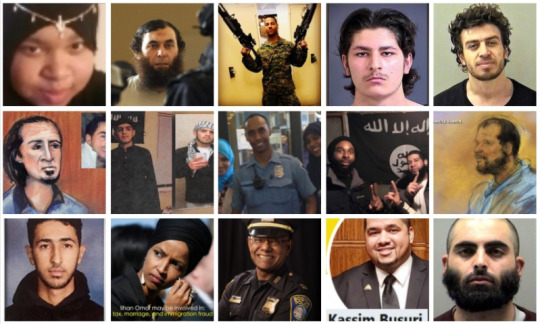
Click any link below for more details and link to original source.
Jihad in America in June
Brooklyn: Muslim Immigrant Sentenced to 20 Years for Attempting to Join Islamic State (ISIS)
Mohamed Rafik Naji was sentenced to 20 years’ imprisonment by United States District Judge Frederic Block for attempting to provide material support or resources to the Islamic State of Iraq and al-Sham (ISIS), a foreign terrorist organization. Naji pleaded guilty to the charge in February 2018.

Brooklyn: Muslim Woman Who Helped ISIS Gets 4 Years, But Will Be Out in 18 Months
With credit for time served, Sinmyah Amera Caesar will end up only serving about 18 months in prison after pleading guilty to charges accusing her of using social media to help recruit IS fighters under the nom de guerre “Umm Nutella.” She had also admitted violating a cooperation agreement with the government a — betrayal that infuriated prosecutors.

Illinois: Bosnian Muslim refugee and mother of 4 jailed for sending money, supplies to ISIS
Mediha Medy Salkicevic, a/k/a Medy Ummuluna, a/k/a Bosna Mexico, 39, was sentenced to 78 months in prison for conspiring to provide material support to terrorists.
Salkicevic, aka Medy Ummuluna and Bosna Mexico, espoused the ISIS philosophy that infidels should be killed and once said that unbelievers should be buried alive.
At the time of her arrest, she was working for an air cargo company at Chicago O'Hare Airport...

Illinois: Two Muslim converts convicted of aiding Islamic State (ISIS)
Joseph D. Jones and Edward Schimenti proudly waved a terrorist flag during a photo at a Lake Michigan park in Zion, had plotted to attack the Navy’s main U.S. training center near North Chicago and once had their eyes on planting an ISIS flag atop the White House.
Now Jones and Schimenti, both 37, have been found guilty of providing material support to ISIS.

Indiana: Yemeni Muslim who tried to join Islamic State terrorists gets 8 years in prison
U.S. District Court Judge Sarah Evans Barker handed down the 100-month sentence Friday afternoon in the case against 21-year-old Akram Musleh, U.S. Attorney Josh Minkler announced.
He admitted in the plea agreement that from about April 2016 through June 21, 2016, he offered himself to the Islamic State of Iraq and al-Sham, also known as IS, knowing it was a “designated foreign terrorist organization.”

Pittsburgh: Syrian Muslim Refugee Arrested for Planning Jihad Attack on Christian Church
Mustafa Mousab Alowemer, 21, a resident of Pittsburgh, Pennsylvania, was arrested today based on a federal complaint charging him with one count of attempting to provide material support and resources to the Islamic State of Iraq and al-Sham (ISIS), a designated foreign terrorist organization, and two counts of distributing information relating to an explosive, destructive device, or weapon of mass destruction in relation to his plan to attack a church in Pittsburgh.
“Court documents show Mustafa Alowemer planned to attack a church in the name of ISIS, which could have killed or injured many people...”

Ohio: Jordanian Muslim Immigrant Sentenced to 15 Years for Trying to Join Islamic State (ISIS)
A Dayton, Ohio man was sentenced today in U.S. District Court to 180 months in prison and 25 years of supervised release for attempting, and conspiring, to join the Islamic State of Iraq and al-Sham (ISIS).
Laith Waleed Alebbini, 28, was convicted following a bench trial in November and December 2018 before U.S. District Judge Walter H. Rice.
Alebbini attempted, and conspired, to provide material support and resources to ISIS in the form of personnel, namely himself.
Alebbini, a citizen of Jordan and a U.S. legal permanent resident, was arrested by the FBI on April 26, 2017, at the Cincinnati/Kentucky International Airport, as he approached the TSA security checkpoint.
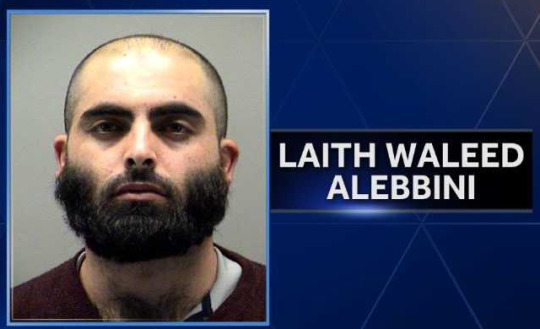
South Carolina: Muslim - twice convicted for attempts to join ISIS and kill Americans - gets 20-year prison sentence
A federal judge has sentenced a South Carolina man who tried to join ISIS to 20 years in prison.
Zakaryia Abdin, 20, pleaded guilty in September 2018. The Ladson man was arrested in March 2017.

New York: Bangladeshi Muslim immigrant arrested in Times Square terror plot
Ashiqul Alam was arrested Thursday after arranging through an undercover agent to buy a pair of semiautomatic pistols with obliterated serial numbers, prosecutors said. Police Commissioner James O’Neill said that development was “a clear indicator of (Alam’s) intent to move his plot forward.”
The defendant, a legal resident born in Bangladesh, moved to the U.S. as a child about 12 years ago...
He talked about wanting to “shoot down” gays, referring to them with a slur; using a “rocket launcher, like a huge one,” to cause havoc at the World Trade Center; and obtaining an enhanced driver’s license so he could walk onto a military base and “blow it up,” the documents said.

Illinois: Muslim Arrested for Threatening to Bomb Aurora Casino for Allah
A recently released affidavit and search warrant claimed that 30-year-old Musatdin M. Muadinov, while detained by police on Feb. 12, vowed to “pray to Allah” to “destroy the casino.” He further demanded to meet with President Donald Trump, saying that if his demands were not met, “we would all meet Allah,” according to the affidavit obtained by the Daily Herald.
Muadinov — who was dressed in what police described as “Muslim attire” when arrested — waived his right to remain silent.

More Jihad in America in June
Florida: Suspect sent bomb threats to judges ‘for cause of Islamic State’
Nebraska: Heavily armed Marine arrested trying to enter Air Force Base
Arizona: Muslim shared terror propaganda before attacking police officer
Brooklyn: Muslim in Jail for ISIS Support Pleads Guilty to Slashing Correctional Officer
South Carolina: Man who pledged allegiance to ISIS hid explosive device in teddy bear
Arizona: Witness in probe of 2015 Islamic jihad attack on free speech event convicted of lying to FBI
Libyan National Found Guilty of Terrorism Charges in 2012 Attack on U.S. Facilities in Benghazi
Iraqi Muslim who orchestrated jihad attack that killed 5 U.S. troops gets 26 years prison, then release to Canada
Immigration Jihad in America
Minnesota’s first Somali Muslim cop gets 12 years for murdering Australian woman
Minnesota: St. Paul’s first Somali Muslim city council member says criticizing his homophobic comments is… Islamophobic
New York: Brooklyn Mosque Blasts Islamic Call to Prayer to 20 Block Radius (VIDEO)
Somalis have Changed Minneapolis
New York: Thousands of Muslims take over two city blocks in Brooklyn to pray in the streets
Four Muslim ISIS suspects arrested in Nicaragua, likely headed for US
Islamization of America
Pennsylvania: 167-year-old Catasauqua church will become Islamic mosque
Pennsylvania: Former Easton church is now a Sunni mosque
Pennsylvania: Former daycare in residential Salisbury to become Muslim “community center”
Virginia: Residential home in Annandale to become a Muslim funeral home
Education Jihad in America
New Jersey Public School District to Students: “May Allah Continue to Shower You Love and Wisdom”
Maryland school fails Christian student for refusing Islamic prayer
New York: Cornell Univ. Muslim Students Demand More “Prayer Rooms”
Stanford administrators say advertising for conservative event threatens Muslim students
The Muslim Brotherhood’s Muslim Students Association: What Americans Need to Know
DOE Investigating Elite Colleges For Hiding Saudi, Qatari Cash from Regulators
Islamic Slavery & Sexual Jihad in America
Virginia: Three Muslim family members arrested for conspiracy, forced labor, and document servitude
Detroit Imam: Wife-Beating Serves to Remind Her That She Misbehaved (VIDEO)
Dhimmitude in Elected Office
Trump Admin Sues Greyhound for Banning Muslim Driver from Wearing Full Length Islamic Robe
Democrat majority passes defense authorization bill that funds transfer of remaining Gitmo jihadis to U.S.
Minnesota: City of Bloomington allows terror mosque to flout local laws (VIDEO)
Minnesota city council votes 5-0 to ditch Pledge of Allegiance (to avoid offending Muslims)
Diversity is our Strength Alert
Minnesota’s first Somali Muslim cop gets 12 years for murdering Australian woman
Minnesota: St. Paul’s first Somali Muslim city council member says criticizing his homophobic comments is… Islamophobic
Boston Police Dept’s First Muslim Captain Put On Administrative Leave Amid ‘Anti-Corruption’ Investigation
Minnesota: First Muslim congresswoman Ilhan Omar fined by state for unlawful use of campaign funds
Minnesota Muslim Rep. Ilhan Omar filed joint tax returns before she married husband
Fraud for Jihad
Connecticut: Muslim Grocery Store Worker Pleads Guilty in $3.2M Federal Food Stamp Fraud
Massachusetts: Muslim Restaurant Owner Pleads Guilty to Tax Fraud Conspiracy
That’s just what we had time to compile for just the month of June.
Far too many steps forward for the sharia, and only a few pushbacks, but worth noting:
New Jersey: School District Scraps Posters Calling upon “Allah” to “Shower” Students with Blessings After Threat of Lawsuit
Rather Than Go to Trial, Terror-linked CAIR Settles with the Victims They Defrauded
Tunisian Muslim who swore allegiance to ISIS removed from U.S.
New York: Albany mosque imam convicted of terrorism is deported back to Iraq
It’s almost midnight and Americans are losing their first amendment rights to sharia supremacists and the big technology, media and politicians who support them.
Please share this report before it’s too late.
65 notes
·
View notes
Text
New Year Regulations that Employers Should Know Beforehand
The Year 2020 brings obligatory regulations both locally and nationwide for Employers to be aware of. Most notably, the Fair Labor Standards Act (FLSA) – the federal wage/hour law – will increase its pay package test to the “white collar” exemptions to approximately $35,000/year effective from January 1st. The Department of Labor (DOL), which is tasked with enforcing the FLSA, estimates 1.3 million currently exempt employees will be reclassified as nonexempt next year by its final rule.
Moreover, many states have enacted paid leave, background checks, drug testing, and non-compete legislation in the past year. As the New Year started, employers are accessing the next set of labor and employment laws and regulations they will face in the current year and beyond. However, as the New Year starts, employers should be sure to review overall state and federal compliance concerning employees, job categories, compensations, paid leave, job requirements, employee handbook language, and employee agreements.
As a conclusion, Securecheck360 would like to remind employers about certain changes that employers should consider while starting the year checklists.
1. Confirm Number of Employees: Due to the latest changes in U.S. laws, both on a local and national level changes in an employer’s business may impact the regulations that apply to it. For instance, if the total number of employees reached 50 across all locations, it may have to comply with the new set of requirements. Employers should count their total number of employees to determine what laws are significant to them. Notable milestones to cross are 15, 20 and 50 employees (for instance, the Family Medical Leave Act applies to organizations with 50 or greater employees, Age Discrimination in Employment Act applies to private associations with 20 or more employees, and Title VII and the Americans with Disabilities Act applies to employers with 15 or more employees).
2. Job Categories and Compensation: Job responsibilities, essential functions, and compensation can change throughout the year. Employers need to assess whether employees are properly categorized exempt vs non-exempt. In September 2019, the DOL increased minimum pay requirements for overtime exemptions for executives, administrative, and professional employees. Under the final ruling, the pay package level for these white-collar exemptions Increased from $23,660 per year ($455 per week) to $35,568 per year ($684 per week). The final ruling increases the annual compensation requirement for an employee to be considered a “highly compensated employee” and exempt from overtime from the current $100,000 per year to $107,432 per year. Employers must note that the highly compensated employee rule allows employers to use non-discretionary bonuses, incentive payments and commissions are rewarded at least annually to satisfy up to 10 percent of the basic salary level.
3. Ensure Vacation and Leave Carryover: As employers finalize employees’ leave carryover and calculate vacation accordingly, they should also be sure to review local and state law’s regulating paid leave this year. More than six states and localities have enacted some type of paid leave laws to take effect in 2020. These states and local regulations affect a variety of employers, some applying to organizations with as few as 10 employees. Effective January 1, Nevada employers with 50 or more employees must provide employees with up to 40 hours of paid leave annually for any reason, with very few exemptions. Washington State has enacted a Paid Family Leave program that requires employers with 50 or more employees to pay a share of the state benefits program. Also, Washington employees are eligible to take up to 12 weeks of paid leave. These are only a few of the newly enacted paid leave laws that came into effect this year.
4. Verify Notices and Posters: Employers must verify that they are up to date and have the latest versions of all the required posters and notices, especially in states and localities with new regulations that may impose additional posting requirements. For instance, New York State’s recent prohibition on discrimination against employees’ reproductive health decisions imposes employer notice requirements. The District of Columbia’s Paid Leave Act requires employers to post and maintain a notice to employees explaining the terms and conditions of their rights to paid leave benefits. These are the only two of several new posting requirements with which employers may be required to comply.
5. Update Policies: Employee handbook policies should reflect your organization’s culture, expectations, and practices, as well as the current state of employment laws, starting this year. Among many common state and local trends related to discrimination, a few localities have joined California in enacting laws prohibiting employers from discriminating against racially specific hair bias. In addition to amendment of non-discrimination policies, anti-harassment, and dress code requirements, employers should also consider reviewing their grooming policies for prohibitions against natural hair, style, and textures, because these prohibitions may violate state laws.
6. Guarantee Non-Compete Agreements Comply with Applicable State Laws: Employers should ensure non-compete agreements comply with any applicable state laws. For instance, Oregon, Rhode Island, and Washington have amended and enacted regulations on employee non-compete agreements. Oregon has amended its current regulation to now require employers to provide employees a signed copy of their non-compete agreement within 30 days of an employee’s termination. From the third week of January 2020, Rhode Island will prohibit employers from entering into non-compete agreements with certain employees, including non-exempt and those 18 or younger. In Washington, non-compete agreements with employees who make less than $100,000 per year are void from this January. Moreover, Washington has enacted a regulation creating a presumption that any agreement lasting 18 months or above is considered unenforceable.
Year start is a busy time for employers, but keeping up with these factors can help ensure a smoother start to the New Year.
1 note
·
View note
Text
Moments Before Disaster
So this is another fic written for Em which was the second thing I wrote before settlingn on the last. Anyways hope you enjoy this angsty little one shot.
The coffee shop is unusually unpopulated for the middle of the day but Sherlock believes that may be due to the large accumulation of police outside the glass windows. Just from his spot alone he can see Bell crouching next to what he assumes is a footprint of a size thirteen work boot, according to reading the detective’s lips.
“Are you going to tell me why we’re standing in the middle of the coffee shop or am I just supposed to play a guessing game,” Watson’s voice beside him is strained, likely due to her own lack of coffee. With the steadily building snow and fresh crime scene of an abduction their evidence would disappear rather quickly with accumulation.
“It is finals season is it not Watson?” He turns to her with a pursed look on his face. He knows the answer because of course he does. She knows he knows the answer but she submits nonetheless. He blames it on her energy. If she’d become more efficient with her sleeping patterns then maybe she wouldn’t be so tired.
“Yes. College kids are taking their finals before winter break, why?”
He nods with confirmation striding to the glass window where a small poster hangs.
24 hour service for our college students facing finals week. The paper proclaims in grotesque neon and slanted letters. “A consumerism trap if there ever was one. Plenty of libraries in the area but college students flock to shops like these for bants rather than studying for claims that the coffee will help them. In reality, they are using less product and more milk and sugar to give that placebo kick of energy needed without wasting money or precious inventory.”
“Is there a point to this rant?”
“Jessica Clemmons was taken from this sidewalk and precisely 4:51 in the morning. It is 5:23 and I believe if we ask around we will find records of a student or students that were in this shop at the time of the abduction.”
“That was an incredibly long winded way of saying we’re looking for witnesses, even for you.” She deadpans. “Give me your card.”
“Honestly, Watson I thought I taught you better than to rob a man in a highly populated area.”
“I could have just picked your pocket. Besides, it’s your turn to buy coffee.”
“I thought it was Bell’s turn,” Nonetheless he shuffles in his wallet and pulls out his plain blue credit card and passing it to her delicate fingers.
“Nope.” She smiles turning on her heel. He can’t help the fond eye roll as she walks away the clicking on tiles marking her journey to the counter. He focuses his attention again on the crime scene at hand. So far the only evidence is the footprint and any potential witness. However, due to the late hour and the lack of effective streetlamps he seriously doubts they’re going to get a description off of anyone there. If they’re lucky they might get a vehicle description but even that feels like a longshot.
He watches Bell reach down and pick something out of the snow. He frowns in realization that it’s the ring he’d seen in Jessica Clemmons’ instagram feed. Recently engaged with a unique Emerald ring, now found abandoned in the snow with no owner in sight. He’d instantly ruled out the fiancee upon arrival, unless he was a sociopathic actor he sorely doubts that what he’s telling is anything less than the truth.
Being New York she could have very well been a random victim. In the wrong place at the wrong time, so the television proclaims. However, Sherlock does not believe in random attacks. From what he could gather from her social medias Jessica is a highly successful lawyer working on a rather controversial case. While he loathes the likes of a person who can defend a blatantly guilty man, she’s on the right side of the law this time. At least, he’s fairly sure from the twenty minute summary he was able to read on the car ride here. Any number of people would be enemies with this woman including previous those of previous cases. Truthfully, they have their work cut out for them on this one.
“Have you mastered the art of reading minds yet?” He blinks rapidly as he’d not heard Watson’s footsteps. He turns his head finding her eyes sparkling with mischief. It’s remarkable that even the thought of coffee has her in an entirely different mood than she’d left in.
“Not yet. Although it would make this case remarkably easier for the both of us.”
“If it was easy then you’d be bored and that’s not good for anyone.”
“Quite right.” He pulls a chair out by the window for Watson while they wait. She shrugs her coat and scarf off, delicately placing the articles over the chair before she seats. Her eyes focus in on the fiancee, likely partaking in some lip reading of her own. “So what’d you get me?”
“Your usual. Black with a teaspoon of honey and a side of cream for filling to your liking.”
“What if I was feeling adventurous?” He tests with a single eyebrow raised.
“You’re not. You’re wearing your plain black socks today and you had a choice between your plaid scarf and your grey one, but you chose the grey.”
“The plaid still smells of aquarium water.”
“Which wouldn’t have happened if you didn’t jump into a dolphin tank without warning.”
“I sincerely doubt warning you of my actions would have stopped me or prevented my scarf from smelling like fish.”
She narrows her eyes and he knows he’s made a good point there. “I’ll have Mrs. Hudson take it to the dry cleaners with my dress I wore that day.”
“Thank you.” He nods. “For the coffee and the offer.” She grins passing back his card which he then places back into his wallet where it belongs.
“Did I miss anything?”
Before he can surmise his initial thoughts a voice rings out from behind the counter. “Americano for Marcus, black with honey for Sherlock, skim milk latte for Joan.”
“Not feeling adventurous either I see.” She shrugs pushing her chair out to receive the order. Just as she grabs the holder the voice rings out again.
“Whole milk latte for Andrew.” It’s like watching a disaster in slow motion. Watson’s eyes glaze over first, her mind shutting off the present. In two steps he’s in front of her, catching the cups as they loosen from her fingers. Some people who noticed his abrupt movement are watching now.
Watson’s breath is beginning to become labored so with one hand he scoops up her coat and scarf, and the other hand still balancing the carrier drives her outside into the cold. He passes the coffees off to the first officer he sees with a command to wait there until he returns. He briefly hears Marcus’s protests as he steers her away but his step doesn’t even falter. He waits until they’re in a relatively private location secured between two buildings before turning to her.
He places the coat over her shoulders first. “Watson,” When she doesn’t respond he takes her hand and places it on his chest. It wasn’t a common practice between them, so much contact, however he’d dealt with a fair share of flashbacks when training Kitty. “If you can hear me, match your respirations to mine.” His fingers cover hers, making sure she doesn’t pull herself away and takes a deep breath. He holds it for seven seconds before exhaling. It takes approximately eight breaths before Watson slips into his rhythm. Her eyes are just beginning to clear when a look of shame sweeps over her face.
“I’m fine.” She mutters pulling her coat tighter with her free hand.
“Do you wish to go home?”
“No.” Her answer is a little more forceful than what’s needed. “I’m sorry. It’s just that it’s been years since-”
“The last flashback.” He finishes for her. “I know.”
“Can we get back to the case?” She asks, her meek demeanor is buried likely not to be seen again for quite a while. Although he doubts this exchange will go without discussion later on.
“Of course Watson.” A small smile graces her lips. He wonders perhaps there were more flashbacks than he knew of. A recovery from that so quick… It’s not common unless one’s adapt to having them. He’s not sure what possesses him but he leans in pressing a soft kiss to her temple. Rather than shock or tensing up, he feels Watson relax into the embrace with her fingers curling into the front of his coat. He breathes in slowly taking in the scent of her lavender shampoo.
Marcus shares a knowing look with him when they emerge once again from behind the brick wall. Barked orders from the detective shushes any rumorous chatter spreading like ashes across the scene.
They settle back into their roles like clockwork to find out who took Jessica Clemmons.
#joanlock#joan watson x sherlock holmes#sherlock x joan#elementary#elementary cbs#marcus bell#fanfic#mentions of ptsd#joan has ptsd
29 notes
·
View notes
Text
Day 111: Anfield
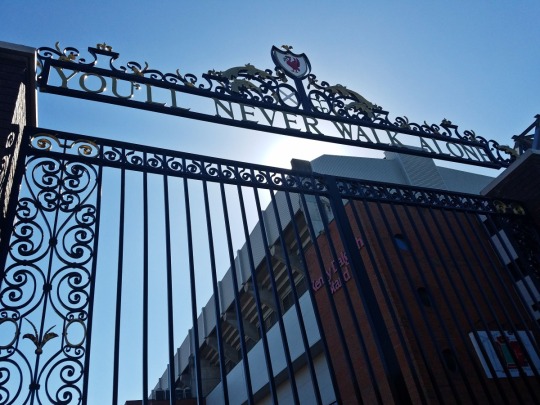
Today we visited Anfield, home turf of Liverpool Football Club and Jessica’s personal sports Mecca. We arrived early, with plenty of time to walk around the grounds and have some lunch before our scheduled tour of the stadium.


We entered through Paisley gate, named for legendary Liverpool player and manager Bob Paisley. Three trophies above the gate represent the three European Cups that LFC won under his management--a record only two other European managers have ever tied--and the crest on the left half of the gate is of Paisley's birth town, Hetton-le-Hole in northeast England.
Just inside the gate is a statue of Paisley's predecessor, the equally if not more legendary Bill Shankly. With Paisley as his assistant coach, Shankly ruthless rebuilt the team (and much of the stadium) from the ground up and dragged it from B-list ignominy into the spotlight as one of the greatest teams in all of Europe.
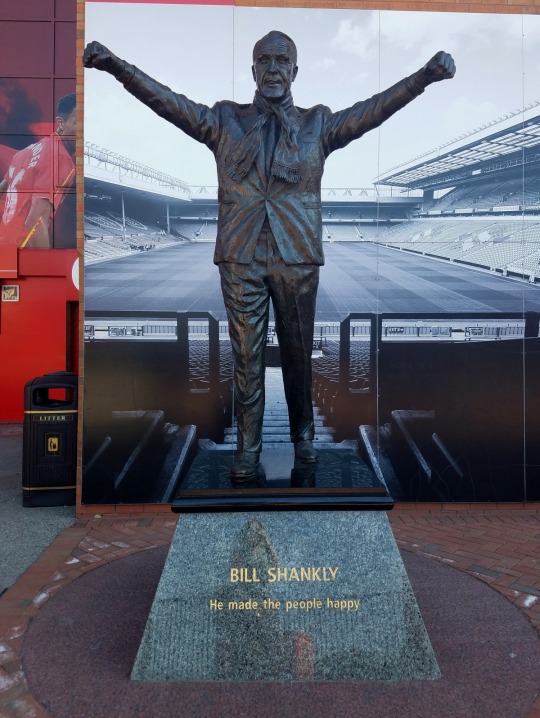
Shankly was famous for his relationship with the Liverpool fans. From the beginning, he insisted that the fans are the most important members of any team, and he saw their faith in him and the organization as sacred. He understood how much the team meant to the people of Liverpool, and always worked hard to show them how much they meant to him in return.
He’s also the one who picked You’ll Never Walk Alone to be the team’s anthem. It was a spur of the moment decision, but it proved momentous. It remains one of the most iconic and beloved anthems in all of sports, and it has since been adopted by numerous other teams around the world, including Celtic FC in Glasgow, Borrusia Dortmund in Germany, and FC Tokyo in Japan.

As the statue says, he made the people happy.

The Liverpool Football Club is rich in history and lore, and every corner of this place honors that heritage with pride, including a monument to one of the darkest chapters in the team’s--and the city’s--history.

ESPN has an excellent "30 for 30" special on the Hillsborough disaster--Jessica had me watch it when we were in York--but I'll do my best to summarize it here.
On April 15, 1989, Liverpool was playing a semi-final match against Nottingham Forest at Hillsborough Stadium in Sheffield. Shortly before kickoff, a surge of fans entered the already overcrowded pens at one end of the stadium. The pens were standing-room-only sections of the stands that were fenced off from the rest of the stands, with only a single gate for entering and leaving.
Panic ensued, and fans and police alike scrambled to tear down the fences and help people escape the crush. When the dust settled, a horrifying 94 people were found dead from crushing or asphyxiation--over a third of them children and teenagers. Over 700 others were injured, including two who would later die form their injuries.

Almost immediately, the police and the Sun newspaper released the story that the disaster had been caused by Liverpool fans who had broken down the gates and recklessly stormed the pens. The rest of the country already thought of Liverpool fans as a bunch of drunken hooligans, so the story was easy to believe.
But it was a lie.
Having failed to sufficiently prepare the grounds and his officers to handle the massive crowds attending the game, Police Chief Superintendent David Duckenfield--the man who officially blamed Liverpool fans for breaking down the gate--ordered himself that the gates be opened to relieve the restless crowds, having apparently forgotten that doing so would lead the throngs directly into already full pens of Liverpool supporters. Even as the bodies were being laid out on the pitch, Duckenfield was calling reporters and debriefing his lieutenants to ensure that only the “correct” officer statements made it into the official record.
False reports were leaked to the press, including absurd claims that Liverpool fans robbed the bodies of the dead, urinated on police officers, and attacked medics trying to resuscitate the victims. For years, Hillsborough survivors and the victims’ families were not only unconsoled but actively villainized as scum.

The Sun is still firmly boycotted throughout the city, and anti-Sun posters are still proudly displayed on walls and taxis.

The Sun finally apologized and recanted the false stories in 2012, but for the people of Liverpool, it was far too little, far too late.
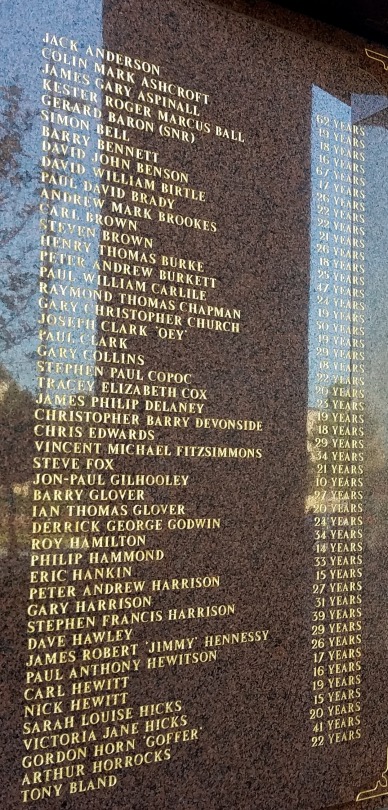
The government inquest that followed the disaster took three years to complete and ultimately ruled all the deaths to be accidental. The inquest declined to accept testimony from two practicing doctors who had been in attendance at the game and were critical of the emergency response provided. The only doctor whose testimony was admitted was that of the hosting stadium’s club doctor.
Meanwhile, an independent government investigation into the police handling of the incident thoroughly and definitively contradicted the official story, clearly exposing the cover-up and laying the blame squarely upon the police and the stadium’s design flaws. The report led to major safety improvements in stadiums across England, but no one was held accountable for the 96 dead Liverpool fans.
Years later, in 1997, the Labor party won control of parliament from the Conservatives. One of their campaign promises was to reopen the investigation into Hillsborough. The result was little more than a sham. The justice appointed to the investigation was openly hostile and derogatory of the people of Liverpool, and he declared that only new evidence would be admitted for consideration.
Since the facts of the police incompetence and cover-up were already available during previous investigations--albeit ignored--they were deemed inadmissible. Unsurprisingly, the investigation upheld that Hillsborough was an accident and no one was at fault.

Finally, after years of bitterness and failed civil suits--funded by the people of Liverpool themselves--a new independent panel was commissioned by the government in 2009 and in 2012 ruled that the Liverpool fans were in no way at fault for the disaster.
Nothing was done about it, but it was the closest thing to justice that Liverpool had gotten in over 20 years since the disaster happened.
Subsequent investigations uncovered the fact that police reports from the incident were not only curated by the brass but forged wholesale. Over a hundred officers’ statements were found to have been either edited without their consent or fabricated entirely, the originals lost to the void.
The story isn’t over. To date, not one person has yet been held accountable for in a court of law. Just this year, charges were brought against chief Duckenfield for gross negligence and manslaughter, and his trial is currently set to begin in January 2019.
Hillsborough is more than enough of a tragedy in its own right, but it’s also a case in point for the relationship between Liverpool and the rest of England. And it’s not hard to see why so many people here see themselves as Scousers first and English a distant second.
Speaking of Scousers, it was high time for something less somber: lunch.

I had my first taste of scouse, a local specialty consisting of spicy meat stew with beets and red cabbage mixed in. Scouse was a popular dish among British sailors, so naturally it became popular in the major industrial port city of Liverpool. Nowadays, the dish is so strongly affiliated with the city that the people of Liverpool are called Scousers and their unique dialect (a blend of English, Irish, and Welsh) is called Scouse.
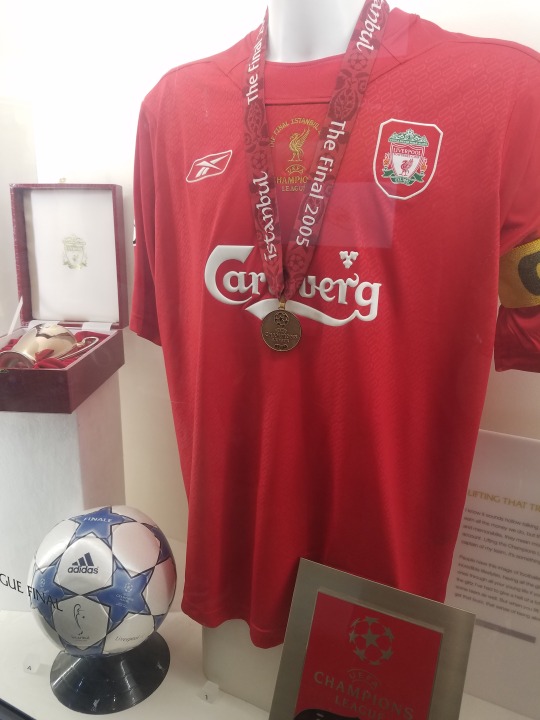
Our hearts and bellies warmed, we headed into the club museum, which was filled with stories and artifacts from the team’s founding in 1892 up through the current year. One room was entirely filled with personal memorabilia from recent team superhero Steven Gerrard, and another was occupied by the team’s five European Champions League cups--two more than the next-best team in Britain, Manchester United.
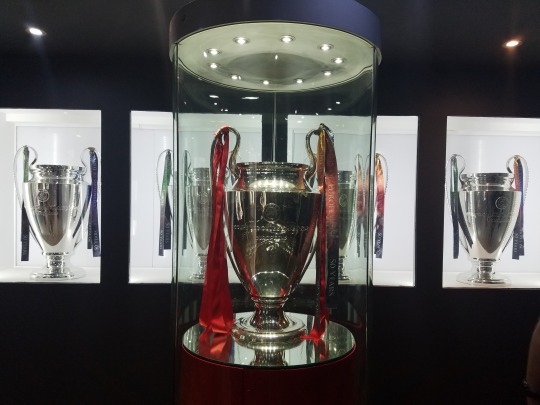
One room in the museum was made up like a section of the stands, with screens and speakers recreating the experience of being at a game while fans around you sing the team anthem, “You’ll Never Walk Alone.” Even as an outsider to football fandom, it was an incredibly moving experience.
Finally, it was time to tour the stadium itself. Jessica had visited the stadium twice before, but this tour was different. Much of the stadium had been recently renovated, and because it was the off-season, the tours were all given on self-guided tablets that we could use to scan various signs and displays for more information. Stationary guides were posted at intervals to answer questions and make sure we didn't get lost.
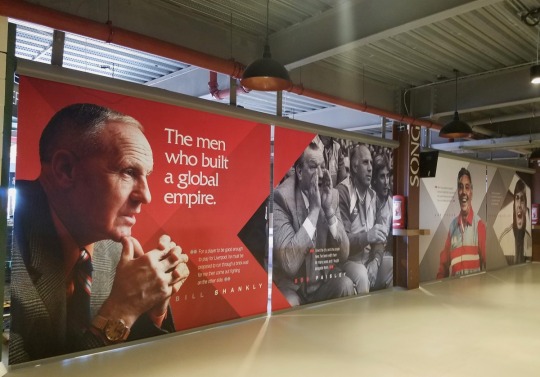

The tour starts on the top floor with a rundown of the team’s best managers and the victories the team earned under their leadership.

Then we turned a few corners and came out into the sunlight and glorious green pitch.


Jessica couldn’t have been happier if she was in Disneyland.
The stands on the right-hand endzone are called the Kop and where the most diehard Liverpool fans sit (if they ever do sit) during home games. The name is used for similar sections in stadiums across England and dates back to the Second Boer War of 1900. Many fields, including Anfield, had hills nearby where people could sit and watch the game. Returning soldiers compared the hills to a South African hill named Spion Kop, where a major battle took place. The hill at Anfield became known as Spion Kopp, then just Kop. Eventually, the hill was leveled to make room for larger stands, and the stands that took its place took on the name as well.
After taking it all in for a good few minutes, we continued on inside the stadium for more displays covering the history of team and stadium.

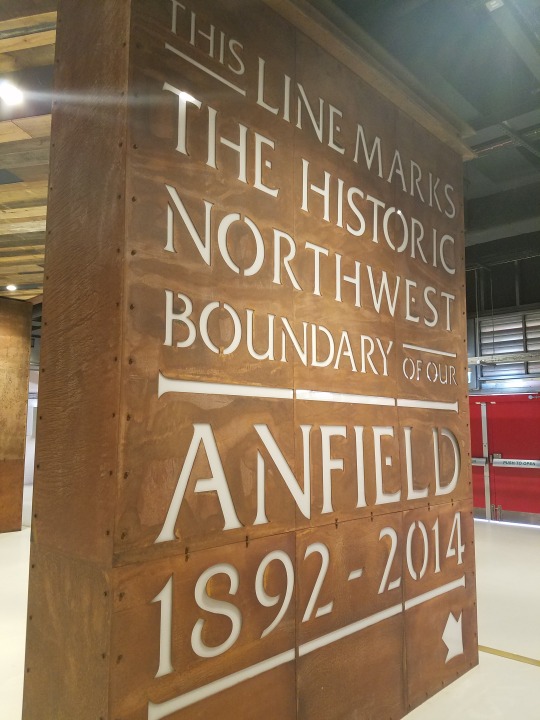
One large window looks out toward the shockingly close Goodison Park, home turf of the rival Everton Football Club.

Our tablets filled us in on the history of the rivalry, but of course, Jessica already knew it all and had long since enlightened me.
Anfield was originally used by Everton, the city’s first professional football team. But as Everton became more and more successful, Anfield’s owner tried to get more and more money out of them. He also wanted to sell booze in the stadium, which the church-owned Everton FC opposed. Eventually, in 1892, Everton got fed up and built themselves their own stadium on the other side of Stanley Park, less than a mile away (and in the backyard of a church).
Left with an expensive new stadium and no team to occupy it, the owner decided to make his own team. And so Liverpool F.C. was born.

Along the way, we ended up talking with one of the stationary guides for a good while. It turned out that the first game Jessica went to at Anfield was also the first game that the guide took his grandson to. They reminisced over the great last-minute goal by Stevie G to win the game.
Somehow, though the conversation kept turning to sad things. When he asked us where we were from, we ended up talking about the terrible fires up in Napa and Sonoma the previous autumn.


Downstairs, we saw the newly renovated dressing rooms, where Jessica was able to get her picture taken with the jerseys of some of her favorite players, including Gerrard and Mané. Using the guide tablets, we were able to scan each jersey to bring up a short interview or highlight reel about the player.
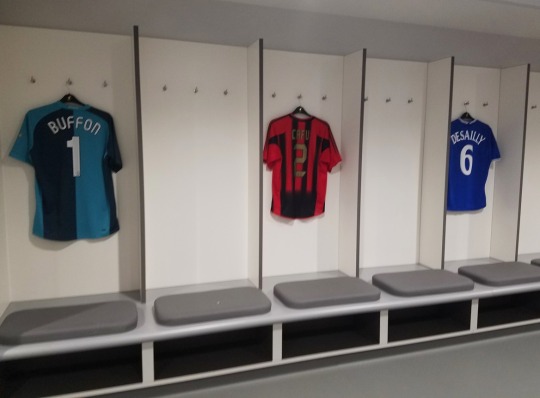
Whereas the home dressing room is warm and cushy, the visiting teams’ dressing room is drab and spartan. A selection of jerseys in the niches showed an all-star team opposing players who've visited Anfield, picked out by former Liverpool defender and local Scouser Jamie Carragher.
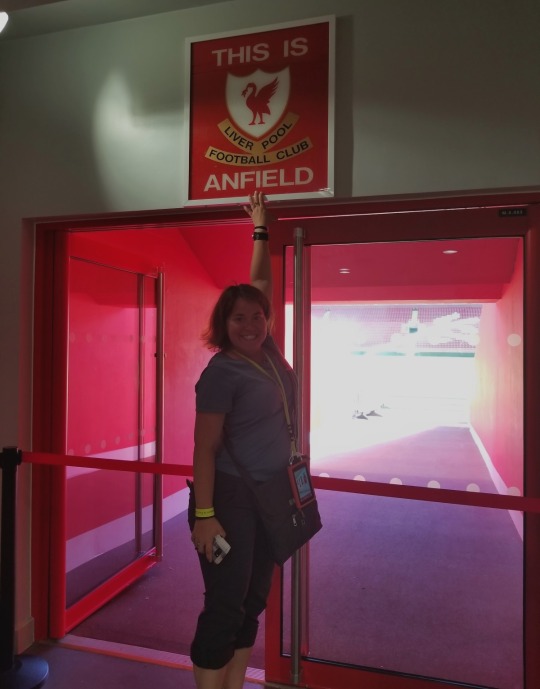
We didn't go onto the field itself--stepping onto the grass of that holy of holies is literally a crime unless you are a player or a groundskeeper--but Jessica got to touch the famous “This is Anfield” sign that the Liverpool players tap every time they go out onto the pitch.
Sadly, we didn’t get to go into the dugout or the Kop since they were both closed for maintenance.

Leaving the stadium, we walked around for a bit and went into the massive new Club Shop. Jessica got some LFC stickers for her laptop, and we both got some refreshments--it had gotten surprisingly late in the day, and we’d done a lot of exploring.
While we were there, a giant-screen TV showed France knocking Argentina out of the World cup, ushering in the Round of 16.
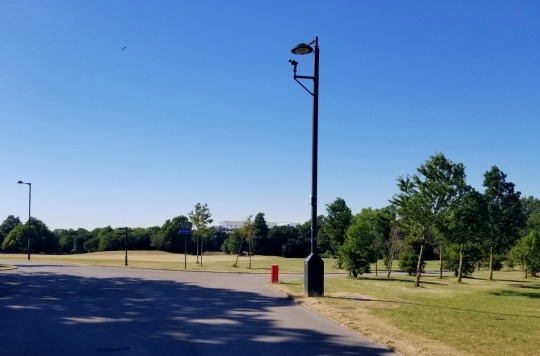
Before heading home, we took a quick stroll through Stanley Park and caught another glips of Goodison.
On the bus back to our Airbnb, we saw another sign of city’s socioeconomic standing.

We ended up missing our stop and wound up back in central Liverpool. Getting home would take another good bit of walking--plus a major detour in search of a convenience store that actually sold decent food--but it all worked out in the end.
Back home, we watched Pirates of the Caribbean 3 and tried to ignore the obscenely loud birthday party next door that went absurdly late into the night for a kid’s party.
Next Post: The Magical Mystery Tour (and a Cathedral, too!)
Last Post: To Liverpool (With the Beatles)
1 note
·
View note
Text
Resistance/protest imagery in NCT’s Limitless MV: graffiti, Muhammad Ali, surveillance, arrest, complicity [analysis pt 1]
Man, so I’ve long thought the Rough version gets misunderstood as a faux-street, too-ugly-to-watch piece of low-res crap without either meaning or storyline. but I believe the MV and lyrics are full of nods to revolution, protest, and “fighting the unjust status quo” – let’s get started.
1. street graffiti as protest speech

What does protest look like? The “civil,” squeaky-clean-legal type can be voting in elections, donating to political parties, and in some countries and U.S. states, mass-assembling in public for “peaceful” demonstrations. Except sometimes people feel disenfranchised by all institutional modes of political participation. Resistance can also be illegal: violence, riots, obstructing traffic, trespassing on private property...and vandalism.
The MV begins with a blurry close-up horizontal pan across a wall of graffiti, and the boys are shown with aerosol spray cans again and again until the end – shaking them, painting with them, chilling with them in the background.






Right away, we’re faced with the puzzle of whether NCT are swaggering revolutionaries...or just angsty, privileged youths defacing public space to “rebel” against their "boring” lives. On one hand, it’s implied by the shabby warehouse littered with cheap goods – pizza boxes, a jumbo cheetos jar, posters taped over un-wallpapered walls- that they’re poor, maybe college students. Yet we see expensive luxury goods that look completely out of place: a glittering chandelier, iMacs, Sony camcorders, guitars, pro lighting kits, Doyoung’s audio mixing panel, the iPhones that they get caught on.




Are NCT 127 a gang that splurges on luxuries? Privileged college students who transplanted dorm items into an abandoned warehouse to film, edit, and produce an indie film? Or maybe they’re a resistance movement using graffiti “writing” as the only alternative media in a censored press, as El Salvador’s FMLN guerilla rebels used graffiti for recruitment, criticism of regime violence against protesters, and commemoration of their fallen from the 70s through the 90s against their brutal (US-backed) right-wing government?
I found NCT’s recurring use of camcorders to be strongly in favor of the (I think) intriguing resistance movement theory...but we’ll get to that later.
Graffiti can be a tool to alleviate boredom or gain fame (or a design career lmao), it can "beautify” urban spaces, and it can serve as gangs’ territory markers. But political graffiti is often the voice of the oppressed in cities where systemic poverty, economic and racial segregation, unemployment, crime, and police brutality ravage communities. In 1989, New York City and Los Angeles each spent over $50 million on graffiti cleanup, and other countries like Peru, Argentina, and Spain are also covered in graffiti that reflect the civil unrest among marginalized indigenous, labor, and student groups.



So is NCT hijacking or co-opting the protest speech of the oppressed? Or are they representing the resistance against injustice in the Limitless MV? I believe they’re consciously paying homage to revolutionaries and activists, as I’ll try to show below, despite the cocky Supreme outfits and sleek, pricey consumer tech.
2. homage to Muhammad Ali: the Greatest (1942-2016)





Who’s that on Mark’s shirt? Called “the Greatest,” the legendary Muhammad Ali was ranked the greatest heavyweight boxer of all time by Ring Magazine and The Associated Press, and the greatest athlete of the 20th century by Sports Illustrated. Ali won gold at the 1960 Olympics at age 18, and is still the world’s only three-time lineal heavyweight champion. He was also a civil rights activist, anti-Vietnam War protester, and a prolific philanthropist.

Muhammad Ali is famous for his 1966 refusal to fight in the then-popular Vietnam War, which he was arrested, stripped of his boxing titles, and charged with draft evasion for – the Supreme Court overturned his conviction in 1971, even though my President hilariously offered to pardon him just days ago. Ali publicly stated:

Today, Ali has a star on the Hollywood Walk of Fame, two Academy Award-winning films based on his achievements, and has graced Time Magazine 5x, and Sports Illustrated 37 times. But his activism antagonized wealthy white America long before he became the mainstream icon that he is today.
Muhammad Ali’s protest to a then-popular war cost him 4 of his prime years as an athlete and landed him in jail, so it’s maybe not surprising to learn that the NSA’s “Minaret” program and FBI’s COINTELPRO operations had been illegally spying on him for years. In 1971, an (also illegal lmao) civilian raid on a Pennsylvania FBI office exposed over 1000 FBI records of surveillance, disinformation, and infiltration plans against civil rights and anti-war activists, and most damningly, of their 1969 assassination of 21-year-old Illinois Black Panthers chairman Fred Hampton in our boy Johnny’s hometown, Chicago.



I mention Fred Hampton and the FBI’s COINTELPRO (COunter INTELligence PROgram) because the whole Limitless MV is steeped in this...unsettling, sinister, you’re-under-surveillance discomfort that many civil rights activists felt in their resistance activities through at least the 50s and 60s. In many shots, NCT look like deer frozen in the headlights, caught off guard by the camera.
3. surveillance of activists & revolutionaries




Besides the general feeling of paranoia about being watched, there’s also shots that look straight-up taken without NCT’s consent or knowledge, as if by a secret camera, spy drone, or informant.


Which leads to the question: if NCT are just poseur revolutionaries partying with camcorders and Supreme streetwear in a warehouse, what are they so terrified of? Why do the members look scared out of their minds, as if for their lives? What danger are they constantly on the lookout for? what are they trying to hide?



I actually think this is the most important pattern to catch from the Limitless MV, even more important than the recurring imagery of resistance and protest that I’ve been writing a whole long-ass post about. If NCT fans remember nothing else about this MV, I hope they’ll remember the members’ reactions of fear, defensiveness, and hostility upon suddenly sensing the camera’s presence in each scene. Limitless is an MV with lots of “swagger” and lots of moments where NCT smiles knowingly for the camera, but there’s also these moments where they’re freaked out by the sudden presence of the camera.
Even if you don’t buy the “revolutionaries” theory, it’s still clear that there’s something profoundly, deeply wrong and disturbing going on in much of the VHS camcorder clips.
4. civil disobedience & riots –> arrests

Alright, so I’ve always thought the YouTube thumbnail for the Rough version looked like Taeil, Jaehyun, Doyoung, and Johnny getting arrested or “frisked” by police, and not just showing off their sculpted side profiles lmao. The image of an apprehended person being told to “put your hands up!” or “get on the ground!” or “put your hands up against the wall!” is burned into public consciousness.
Police want to check that the person is unarmed, or unable to reach for a weapon, hence the order to keep palms spread in plain sight.



As you can guess, unpopular peaceful protests are often labeled “riots” and result in arrests, like in the Sir William George “riot” of 1969 in our boy Mark’s own Canada, even if participants only started throwing objects to prevent their forcible removal by armed police upon their arrival.
Several other scenes also struck me as drawing heavily from the imagery of arrested protesters: while I can’t catch the hangul in the background signs (can you?), I get the vibes of police photo lineups and “mugshots” from this shot:



At least, I get that vibe from Doyoung and Taeil on the right. It’s made more discomforting because why the hell is Jaehyun upside down? he looks like he’s being...tortured? and why is Johnny holding him in that position? The boys look like they’re aware they’re being photographed, then catalogued.
In the final few shots, NCT are shown huddled together in poor lighting and throwing sparkler fireworks in arcs that remind me of “armed” protesters throwing rocks, bottles, gas canisters, or molotov cocktails at riot police.


The pose struck by someone throwing a long-range projectile looks the same no matter what the protest is against: a right-wing government, settler colonialism, locally harmful infrastructure like pipelines or military bases, strike-breaking, austerity, police violence, martial law, a verdict, state corruption, high-profile arrests and convictions, food shortages and unemployment under a left-wing government, an inauguration, etc. Anonymous graffiti artist Banksy even produced this meme-famous piece riffing on this iconic pose:





The images above are from Gaza, the Stonewall Inn in New York City, Paris, and Athens – and there’s plenty more to show from Baltimore, Standing Rock Indian Reservation, and outside of the U.S. too. But back to the act of NCT throwing ~lit~ fireworks into the air: how do we know if they’re punks who are celebrating or protesters who are rioting?
Since there’s never anyone else shown in the MV except NCT, we can’t tell for sure. But I’m inclined to take the maybe-protesting shots along with the maybe-arrested scene and the maybe-police-photo-lineup scene as belonging to one theme that also explains the graffiti, Muhammad Ali / boxing references, and the pervasive fear of being watched: the theme of resistance.
Also, intriguingly, remember how it was Taeil, Johnny, Doyoung, and Jaehyun who were maybe-arrested and maybe-photographed in a police lineup? Earlier, these guys jostle each others’ shoes in a circle, as if sealing a mutual pact with a secret handshake. Later, the same four are shown arrested.


By the way, there’s a couple of secret handshakes in this MV: gang signs? college boys antics? the identification codes of a legit resistance movement? no one knows.


If we believe Limitless to be the (sketchily told) story of NCT’s resistance, we might speculate that TI, JN, DY, and JH took mutually agreed-upon actions that resulted in their arrest and detention. Still, all of NCT lights their sparklers together, and all of NCT throws them into the air. What do you think?



It also makes you curious: what could they have done? Staged a sit-in? a walkout? a strike? a march? a riot? sprayed graffiti and got caught? or maybe, as I’ll half-seriously propose in Pt 2, they organized a forbidden film screening?
4. 🙈🙉🙊 & “monkey see, monkey do”

There’s a couple of old sayings about monkeys, human behavior, and morality. In the above shot, Yuta records as Mark arranges his body into the gold gorilla statue’s crouching position, and we’re shown this footage in the next scene.

That gold gorilla statue...can actually connect us to more meaningful interpretations of the MV. We see Mark bizarrely, weirdly, almost disturbingly, mimicking the position of the primate with great sensitivity to detail – why is it so unsettling? For me, it’s because he looks almost brainwashed or exploited while doing it. Mark is meticulously copying the example of an inanimate object, and he doesn’t laugh or show signs of having fun either. In fact, he looks almost anxious about messing up.
Later on, we see a highly symbolic shot of all nine boys placing their hands over their eyes, covering their sight as if to say, “see no evil.”

There’s no practical reason for all of NCT to cover their eyes indoors, so it’s not literal, it’s a metaphor. In Western culture, the act of deliberately impairing one’s sight evokes the idiom “to turn a blind eye.” That is, when a person knows evil is happening but doesn’t want to fix it, they can pretend the evil doesn’t exist by covering their eyes so they “see no evil.”
By the way, Kim Namjoon recently shared in a Billboard interview that BTS’s Fake Love choreo references the old “three wise monkeys” saying: see no evil, hear no evil, speak no evil.

Here, Winwin covers Taeyong’s mouth while they both steadily meet the camera’s gaze. Their stillness and the camera’s smooth zoom in HD, in such contrast from previous low-res scenes that had almost spastically shaky camera motion, emphasizes this setup as another metaphor, instead of a literal action taken by characters within the story of Limitless.
NCT is trying to send us a message in this scene, it seems: that leader Taeyong, and thus maybe all of them, are being silenced for whatever reason and can’t speak the truth. They can look us dead in the eye, but there’s certain things they can’t say out loud –maybe because of the offscreen danger that keeps them living in fear.
I’ll add that I believe the “see no evil” part is meant to evoke the unsettling idea that people, especially youth, are ignoring the present-day evil or injustice in their own countries – the complicity of their willful blindness. The recurring lyrics “wake me u-up” and “open your eyes”( 눈을 떠 봐 오) in the chorus reinforce this association. Back to Mark mimicking the gold gorilla, the old pidgin saying “monkey see, monkey do” refers to the act of learning or mimicry without either knowledge or concern for the consequences.
Is this a critique of youth uncritically adopting the beliefs of their parents and mainstream society without thinking about the systemic injustices they condone and perpetuate? I think the answer depends on the viewer’s interest in politics and comfort with interpreting works that haven’t been explicitly explained by a creator lmao.
conclusion & lyrics.

I think I’ll stop Part 1 here lolol, since there’s still so, so much left. The plan is for Part 2 to introduce the origins of Third World Cinema and the Korean Independent Filmmakers Association (KIFA) as possible influences but, most definitely, amplifiers for the images of resistance used in the MV. Part 2 will address the...uh, limitless cinematic storytelling styles used in the Rough version, and the effects of editing them together into one MV to tell one story.
I also super-duper recommend @seasquared‘s “Direct Address” essay for a more complete idea of the viewer’s gaze as intruder into NCT’s world – though I sort of interpret the boys’ unpreparedness for the camera’s presence as more of a metaphor for resistance movements’ existential paranoia at being “caught” by the establishment than as a critique of fans’ objectification of idols:
Oh baby it’s you
It’s only the beginning, the limitless me || 이제 시작이야 무한의 나
From the start of the East to the end of the West || 동의 처음과 서의 끝 쪽부터
The light gets stronger || 빛은 암흑 속 퍼질
As it spreads through the darkness || 수록 강해져 가
Open your eyes || 눈을 떠 봐 오
My song is getting louder || 점점 커져가 나의 노래가
Did you see? That hot and explosive world? || 봤니 뜨겁고 터질듯한 세계
Can you hear? We have become one || 들리니 우리는 하나가 돼
Baby I don’t want nobody but you
[trans from colorcodedlyrics.com]
If we choose to interpret “the light” as a revolutionary movement, which my eagerly politics-following ass thinks is a meaningful exercise, the lyrics and MV might suddenly start to paint a story of NCT as underground revolutionaries who meet and fall in love with a new friend, eventually begging the friend to join them in the resistance.
I absolutely love it – Limitless then simultaneously becomes a greasy recruitment message (”baby I don’t want nobody but you 😘”) and a desperate plea for a fellow citizen to join the cause against oppression. (”open your eyes”) But it’s also a passionate love song, and I’m a total hoe for the scorchingly intimate hunger the lyrics convey. The obvious “thirsty, thirsty, f-or love” bit aside, the speaker in the lyrics is urgently seeking intimacy: both a personal connection, and a sense of belonging within something greater than himself.
I need a connection, I want it like crazy
I need you
I need something to make us feel each other completely
I need you
Help me so I can do well
Sometimes, I get lost
Eventually, we are all connected
You know this
Like finding a big ocean
At the end of a desert
Your existence is limitless
Change the heavy world
Look how free we are, so free
Inside, only you are allowed
The one to take my heart, that is you
I think it’s interesting to ask: is Limitless more of a love song that borrows its ferocity from the metaphor of revolution, or a revolutionary manifesto that amplifies its fervor with the universal passion and frustration of youth?
I think it’s similar to asking if the MV is more of an “aesthetics” moodfilm that boosts its own glamor by appropriating the imagery of resistance movements (graffiti writers), activists (Muhammad Ali), and hardships (arrest)...or if the MV is itself a story of resistance against oppression, and only dons the gloss of expensive streetwear to add a spirit of youthful cockiness and anti-establishment swagger to the cause.
But in reality, aren’t things more complex than that? The spirit of any revolution and the passions and frustrations of its youth have always fed and strengthened each other, I think. It feels only honest and hard-hitting that a song about youth-led revolution would also be a hungry, impatient love song.
I hope you enjoyed reading this – I’ll die of joy if you decide you want to comment, discuss, message, or interact with me or other fans in whatever way about any of this!
~ masterlist link ~
#nctwriters#kpop mv analysis#kpop theories#nct theory#nct analysis#nct theories#mv analysis#muhammad ali#graffiti#banksy#protest#molotov cocktail#riot police#fred hampton#cointelpro#surveillance#see no evil#three wise monkeys#speak no evil#monkey see monkey do#fake love choreo#limitless#limitless theory#nct limitless#rough ver#nct limitless mv#omg sorry for all these tags guys#do they even do anyhtign like??
7 notes
·
View notes
Text
Amazon Unlawfully Confiscated Union Literature, NLRB Finds
Amazon illegally prohibited an employee from giving workers pro-union literature, confiscated that literature, and gave workers the impression that their organizing activity was being surveilled at the company's Staten Island fulfillment center in New York, according to National Labor Relations Board charges and other documentation reviewed by Motherboard.
An NLRB investigation found that Amazon illegally prohibited Connor Spence, a Staten Island employee involved in union organizing, from distributing pro-union literature in a break room on May 16—and then confiscated the literature—also in violation of U.S. labor law, according to evidence provided by the NLRB to the union’s attorney.
Connor Spence, a 25-year-old warehouse worker in Amazon's JFK8 fulfillment center in Staten Island, who filed the unfair labor practice charge, told Motherboard that on May 16, he was in the break room distributing leaflets about unions and copies of a notice that Amazon had to post in a Queens warehouse for violating workers’ union rights, when an Amazon security guard approached him and told him he did not have permission to distribute the leaflets.
“He took the union literature away and wouldn’t give it back,” Spence told Motherboard. “I filed the charge so that there’s accountability in place that prevents them from doing this in the future.”
Following the defeat of a high-profile union drive at a warehouse in Bessemer, Alabama this April, Amazon warehouse workers in Staten Island have been busy organizing their own independent union, known as Amazon Labor Union.
“Amazon is very obviously anti-union. They cross the line a lot when it comes to stopping workers from unionizing,” Spence said. “Unfortunately labor law isn’t very strong in our country, but I’m hoping Amazon cares about its image and these stains on their record.”
The finding comes on the same day as an NLRB officer in Alabama released a report recommending the rerun of a union election in an Amazon warehouse in Bessemer, Alabama. The Bessemer campaign marked the highest profile effort to date to unionize an Amazon warehouse in the United States, and inspired groups of Amazon workers around the country to take steps toward unionizing. The NLRB’s report on the Bessemer election found that Amazon illegally discouraged labor organizing, in part by pushing post office officials to install a mailbox outside the warehouse where workers were urged to drop their mail-in ballots, which an NLRB officer wrote “destroyed the laboratory conditions and justifies a second election.”
In recent months, Amazon has spread anti-union messaging similar to that used in the Bessemer union drive at its Staten Island warehouse with text messages that said “Don't be misled by union organizers wearing Amazon vests,” signage in bathrooms, monitors throughout its warehouse.
The NLRB investigation also found that Amazon illegally created the impression of surveillance of workers’ organizing activity at JFK8 on May 24.
Most weeks, large groups of workers have gathered for union barbecues on the sidewalk outside the warehouse with hotdogs, hamburgers, baked ziti, and seafood mac and cheese. Spence said that on May 24, a group of pro-union workers was holding one of these barbecues under a couple of tents, when a security guard approached from a nearby parking lot and held up her phone to take photos of the organizers. Motherboard reviewed a photo of the security guard taking photos.

Amazon Labor Union
Under the National Labor Relations Act of 1935, it is illegal for employers to interfere with or retaliate against workers involved in union activity, including by surveilling or creating the impression of surveillance of union organizing. During the past year, the NLRB has repeatedly found evidence that Amazon has illegally violated these laws.
“The penalties for violating the [NLRA] are meaningless,” said John Logan, an expert on the union avoidance industry at San Francisco State University. “[For Amazon], it’s the cost of doing business. You can make a case that Amazon falls into the category of the worst offenders, a poster child for labor law violations.”
In Spence’s case, the NLRB has made a finding of merit to the charges, and has indicated that it plans to issue a formal complaint. A finding of merit is not an official decision, but a crucial step in an ongoing proceeding. Amazon will now have the opportunity to settle. If Amazon does not agree to do so, then the NLRB will schedule a hearing before an administrative law judge.
Amazon did not respond to a request for comment about Spence’s charges and its anti-union activity in Staten Island, but told Motherboard regarding the election in Bessemer, “Our employees had a chance to be heard during a noisy time when all types of voices were weighing into the national debate, and at the end of the day, they voted overwhelmingly in favor of a direct connection with their managers and the company. Their voice should be heard above all else, and we plan to appeal to ensure that happens.”
Amazon Unlawfully Confiscated Union Literature, NLRB Finds syndicated from https://triviaqaweb.wordpress.com/feed/
0 notes
Text
Press: Emilia Clarke, on the Hollywood throne
The original article is in French and I just used Google to translate it so it might not be 100% correct.
THE PARISIAN WEEKEND. As she is currently shooting the latest episodes of the Game of Thrones series , the actress is on the new Star Wars saga . Meeting with a feminist who knows how to assert herself.
On the third floor of the chic New York Edition, in the heart of Manhattan. Pink complexion, luscious lips and eyebrows provided, a small silhouette of 1.57 meters advances towards us. British actress Emilia Clarke , 31, breaks the screen in Solo: A Star Wars Story . This tenth film stamped Star Wars , in theaters on May 23, focuses on the youth of Han Solo, cult character of the intergalactic saga.
His name may not tell you much. The actress is best known for playing, since 2011, Daenerys Targaryen (aka “Khaleesi” or “Mother of the Dragon”), one of the main roles of the medieval-fantasy series Game of Thrones .
For those who have never looked at it, booster shot. Daenerys, fallen heiress, reduced to slavery by a band of savages, will gradually free himself from his chains by taking the lead of an army of oppressed. The episodes follow one another and the young woman, a fine military strategist, asserts herself as a leader of men and dragons (yes, yes). His goal: to run for the famous Iron Throne.
“To embody this character, it really gave me confidence,” she says. Surrounded by her “court” – makeup artist, hairdresser, stylist and press officer ready to respond to any of her desires – Emilia Clarke, stern look, seems to have been impregnated with the imperial charisma of her double on the screen.
This natural brunette even sports, for a few months, immaculate blonde hair , like his character! But the Game of Thrones adventure will stop soon. The last episodes of the series are currently being watched and will be broadcast from April 2019.
“I will soon have to find out who I am without Daenerys. It’s very exciting ! She enthuses. Her dreams ? One day play a female James Bond and share the poster with Leonardo DiCaprio.
Emilia Clarke has ambition. It goes back to childhood. The young woman grew up in the countryside of Berkshire County, between Oxford and London. His father is a sound engineer for musicals. His mother climbed the ladder of a consulting firm. “He gave me his artistic fiber, he taught me to sing and play several instruments. She gave me her character as a lioness, “she says proudly.
The desire to become an actress comes to him very small. At home, she watches over romantic comedies with Audrey Hepburn. She follows her brother to St Edward’s School, a private school in Oxford. A “different” pupil, Emilia does not find her place among her comrades “who all dream of becoming lawyers”. She then postulates at several schools of drama. What refusals!
The young woman leaves a few months traveling in Asia, then retries her chance. She is finally admitted to Drama Center London, one of the most prestigious British theater schools, from which Colin Firth and Michael Fassbender, among others, have come out.
“This training is very demanding. It prepares you to face an industry that does not forgive mistakes, “she says. Nicknamed the “Trauma Center”, this establishment has the reputation of pushing its students in their entrenchments. It is mostly played roles of old lady or prostitute. Obstinate, Emilia Clarke graduated in 2009.
His first year out of school is difficult. She gets a role in Triassic Attack (2010), a TV movie series Z broadcast on the channel Syfy, but has to chain the jobs of waitress or employee in a call center to pay his rent … It speaks then an audition for “a series with dragons”. The producers are looking for a blonde and slender actress. She is dark and not very tall.
Without really believing, she does some research on Google to learn about Game of Thrones , the literary work of a certain George RR Martin . The creators of the series are finally seduced by her spontaneity, her humor – Emilia Clarke embarked on a “chicken dance” during her audition – and her strength of character.
The first season of Game of Thrones airs in 2011. It earns the actress the Emmy Award for Best Supporting Actress in a drama series. Then Emilia Clarke gets noticed in two discrete British films: Spike Island (2012), Mat Whitecross, a comedy drama never released in France, and Dom Hemingway (2013), Richard Shepard, a crazy thriller where she plays alongside of Jude Law.
Nudity on the screen, a sensitive subject
Game of Thrones , whose popularity is growing year by year, is at the center of the debate. Praised for her female characters who lead men by the nose, the series is also labeled “machismo”, especially for its tendency to strip her heroines, Daenerys – and therefore Emilia Clarke – in the lead.
However, when asked the young actress, elected “Sexiest Woman of the Year” by Esquire magazine in 2015, his opinion on the issue is the radio silence. His press officer even orders us to change the subject. We touched a chord.
She who expressed herself willingly a few years ago decided to say nothing more. No doubt she keeps in mind that in 2013, when she walked the Broadway boards in the room Breakfast at Tiffany’s , the critics had much more talked about the time when she entered naked in his bath that his performance .. .
Anxious not to be stowed in a box, she even declined to star in the series Fifty Shades of Gray (2015) because of her too many sex scenes. And has reduced his naked appearances in Game of Thrones as the seasons, when it was not replaced by a lining.
Better paid than a man
Emilia Clarke prefers to mention her commitments. Anti-Trump assumed, the English spoke against the Brexit and posted on his Instagram account a message of support to the British Labor Party. A convinced feminist, she confirmed that she chose to choose independent women’s roles. In Terminator: Genisys (2015), she plays, alongside Arnold Schwarzenegger, Sarah Connor, rebel icon of the saga. And in the romantic movie Avant toi (2016), she plays a fanciful and determined young woman.
“Feminism is leading the life I want without being defined by my gender. I think that if we say “no” to films that do not give enough space to women, they (producers, Ed) will stop doing, “she says.
Emilia Clarke, with a character to say the least, is formidable in business. For her role in Terminator: Genisys , she would have been better paid than Schwarzy … and would have received more than 10 million dollars for his participation in the season 7 of Game of Thrones ! Without confirming these rumors, she concedes with a laugh: “I am a good negotiator! ”
Next project for her, creating her own production box. “As soon as I finish Game of Thrones , I put myself in it,” promises the one who is already writing a screenplay. After the dragoons, Emilia Clarke intends to tame Hollywood.
Gallery Link:
PHOTOSHOOTS & OUTTAKES > 2018 Le Parisien
Press: Emilia Clarke, on the Hollywood throne was originally published on Enchanting Emilia Clarke
#emilia clarke#game of thrones#game of thrones cast#GOT cast#daenerys targaryen#me before you#terminator
1 note
·
View note
Text
All Architects Must Be Covid-19 Architects
How the Georgia Senate January 5th election will affect global architects, President Biden Architecture, US Building News
All Architects Today Must Be Covid-19 Architects
Historic US Election Review of Architectural Aspects: Architectural Column by Joel Solkoff, PA, USA Dec 21, 2020
Architecture under President Biden Part III
Joel Solkoff’s Column Vol. VI, Number 6
Reproduced by permission toybox tech; available as a poster
https://ift.tt/2J9bkdV
“You can fool some of the people all of the time and all of the people some of the time, but you can’t fool all of the people all of the time.” — Abraham Lincoln
Representative Marcia Fudge, Democrat, Eighth Congressional District of Ohio. Photo in the public domain
No New Housing: Impact of the Trump 2020 HUD Budget
On March 11, 2019, the Trump Administration released its Fiscal Year 2020 Budget Summary. The White House is proposing more than $9 billion in cuts to critical housing programs. The House of Representatives FY 2020 Spending Bill would increase the funding levels of those programs by more than $3 Billion.
Selected ProgramsFY19 FinalFY20 Trump ($/% Change)House FY20 ($/% Change)Community Development Block Grant (CDBG)$3.365 B$-3.365 B / -100%$0.235 B / 6.98%Public Housing Capital Fund$2.775 B$-2.775 B / -100%$0.08 B / 2.88%Public Housing Operating Fund$4.653 B$-1.79 B / -38.47%$0.1 B / 2.15%HOME Investment Partnerships Program$1.25 B$-1.25 B / -100%$0.5 B / 40%Housing Choice Voucher Renewals$20.313 B$-0.197 B / -0.97%$1.087 B / 5.35%Section 202 Housing for the Elderly$0.678 B$-0.034 B / -5.01%$0.125 B / 18.44%Section 811 Housing For Persons with Disabilities$0.184 B$-0.027 B / -14.67%$0.075 B / 40.76%Project-Based Rental Assistance$11.747 B$0.274 B / 2.33%$0.843 B / 7.18%Total For Select Programs$44.965 B$-9.164 B / -20.38%$3.045 B / 6.77%
Thank you www.affordable housing.com
DATELINE Saturday December 19, 2020. Memorial Sloan Kettering Cancer Center, New York, New York. I have moved to New York City, where I was born. to escape the inpending death toll rural Lycoming County will experience within the next few weeks. After the virus is controlled, I will return to beautiful Williamsport Pennsylvania and its architectural treasures on February 14th. I am currently in the hospital to take care of a series of too long neglected health problems anticipating that I will receive the coronavirus vaccine shortly.
I took this self portrait in June 2015 of the less than friendly disability entrance to Trump’s International luxury hotel and apartment condominium complex at Columbus Circle. Following the principles of unversal design would have been preferable if Trump’s de facto instructions were not based on stairs and hoopla.. I waited an unnecesryily long time for the elevator and became soaked as a consequenc. Hell of a way to treat a cancer patient returning to my friend’s place after therapy.
This is how The New York Times described the building in April, 1996: “Fancier than Trump Tower. Glitzier than the Trump Taj Mahal. Pricier than Trump Palace or Trump Parc. Its glossy brochure trumpets Trump International as ‘the most important new address in the world.’
How the outcome of two senate races in Georgia will affect global architecture commisions
Let us start the analysis of the Georgia January 5th election with the big picture.
The big picture: As of yesrerday, 313,797 children, women and men have died from the crnavirus according to the Centers for Disease Control base in Atlanta.
On the glass is half filled for architects, take joy from President elect Joe Biden’s selection of Rep. Marcia Fudge to run the Department of Housing and Urban Development. Here is Rep. Fudge from her official website: “Congresswoman Marcia L. Fudge is a committed public servant who brings a hard-working, problem-solving spirit to Congress and to the task of creating jobs, protecting safety net programs, and improving access to quality public education, health care and healthy foods. First elected in 2008, she represents the people of the 11th Congressional District of Ohio.
youtube
Congresswoman Fudge serves on the Committee on House Administration, House Committee on Agriculture and House Committee on Education and Labor. She is the Chair of the Committee on House Administration Subcommittee on Elections and Chair of the Committee on Agriculture Subcommittee on Nutrition, Oversight and Department Operations. She serves on the Subcommittees on Conservation and Forestry (Agriculture), Civil Rights and Human Services (Education & Labor) and Health, Employment, Labor and Pensions (Education & Labor). In the 115th Congress, the Congresswoman served on the House Committee on Education and the Workforce Subcommittees on Early Childhood, Elementary and Secondary Education and on Health, Employment, Labor and Pensions. She also served as Ranking Member on the House Committee on Agriculture Subcommittee on Conservation and Forestry and a member on the Subcommittee on Nutrition. She is a member of several Congressional Caucuses and past Chair of the Congressional Black Caucus. ++++
youtube
++++ Congresswoman Fudge consistently fights for voter protection, equitable access to a quality education from preschool through post-secondary programs, child nutrition, food stamp (Supplemental Nutrition Assistance Program) recipients, access to locally grown, healthy foods, fair labor practices, and civil and human rights, among other issues. Additionally, she remains a steadfast advocate to strengthen and preserve Social Security, Medicare and Medicaid. Congresswoman Fudge has served the people of Ohio for more than three decades, beginning with the Cuyahoga County Prosecutor’s Office. She was later elected as the first African American and first female mayor of Warrensville Heights, Ohio, where she led the city in shoring up a sagging retail base and providing new residential construction. Congresswoman Fudge earned her bachelor’s degree in business from The Ohio State University and law degree from the Cleveland State University Cleveland-Marshall School of Law. She is a Past National President of Delta Sigma Theta Sorority, Inc., and a member of its Greater Cleveland Alumnae Chapter. Congresswoman Fudge’s work ethic, problem-solving approach, and ability to build collaborative relationships have earned her a reputation among her colleagues in Washington and at home as an insightful leader and knowledgeable legislator. As a dedicated public servant, she begins each morning with a firm promise “to do the people’s work.” It is this simple philosophy that defines Congresswoman Fudge as a Member of substance and character who always keeps her promise.” ####
Our Delusional President Trump flew to Georgia this week to campaign for Senators David Perdue and Kelly Loeffler
youtube
Embedded under YouTube licensing agreement
====
youtube
Embedded under YouTube licensing agreement
Senator David Perdue, Incumbent Republican
Wikipedia – David Alfred Perdue Jr. (/pərˈduː/; born December 10, 1949) is an American businessman and politician. A member of the Republican Party, he has served as the senior United States Senator for Georgia since 2015.
After 12 years as a management consultant, Perdue became the senior vice president for Reebok. He later joined PillowTex, a North Carolina textile company.[2][3] He subsequently served as CEO of Dollar General.
Perdue ran for U.S. Senate in 2014, defeating Democratic nominee Michelle Nunn. He is running for reelection in 2020 against Democratic candidate Jon Ossoff. As neither candidate received more than 50% of the vote in the November 3 election, they face each other in a January 2021 runoff election. After the November election, Perdue called for the resignation of Georgia’s top elections official and claimed without evidence that there were unspecified “failures” in the election. He later supported a lawsuit by Trump allies seeking to overturn the election results.[5]
Perdue was linked to the 2020 Congressional insider trading scandal for allegations of STOCK Act violations. The allegations arose after he sold stocks before the 2020 stock market crash using knowledge speculated to be from a closed Senate meeting After reviews by the Senate Ethics Committee and the U.S. Department of Justice, Perdue was not charged with any crimes. The Justice Department closed its inquiry in mid-2020.
Democratic challenger Jon Ossoff
N.B. Two years ago I doanted $18 to Jon Ossoff’s campaign for the House of Representatives from Georogia. The election was to fill a vacant seat that happened when Re. Azar left thye House to become a an awful Secretary of Health and Humman Services for President Trump. The number 18 has spritual signifcance because the Herew alphabet applies numbers to lwtters. The Hebrew word for life [chai] is 18. In synagogues, i ndoners add 18 to their conytibutons to their synagogue. Also works for causes. In 1952 and 1956 my mother donated $18 to the Presidential campaigns of Adkai Stervenson.Photo in the public domaine.
Wikipedia: Jon Ossoff: “Thomas Jonathan Ossoff (/ˈɒsɒf/; born February 16, 1987) is an American politician and investigative journalist. He is the Democratic Party nominee for the 2020 U.S. Senate election in Georgia, running against Republican incumbent Senator David Perdue. Neither candidate reached the 50% threshold on the November 3 general election, triggering a runoff election on January 5, 2021.
Ossoff was the Democratic nominee in the historically expensive 2017 special election for Georgia’s 6th congressional district, which had long been considered a Republican stronghold. After finishing first, but without a majority in the all-party primary election, he lost the runoff with 48.2% of the vote to Republican Karen Handel‘s 51.8%. Since 2013, Ossoff has been managing director and chief executive officer of Insight TWI, a London-based investigative television production company that works with reporters to create documentaries about corruption in foreign countries. ####
youtube
Embedded in keeping with YouTube licensing.
e-architect’s Architects for Change Webinar Sereis resumes Valentine’s Day February 14 2021
Stay tuned to our calendar for details
youtube
Coming soon to Joel’s problem, further analysis of the Georgia senate race and the impact of its outcome on the country at large.
My editors beckon: “All right, stop writing, Joel.”
Isabelle Lomholt and Adrian Welch, Editors at e-architect Joel Solkhoff, PA, USA: Selfie, Lycoming County, Pennsylvania, USA Please feel free to phone me at US 570-772-4909 or send an e-mail [email protected] Copyright © 2020 by Joel Solkoff. All rights reserved.
youtube
The firm produced BBC investigations about ISISwar crimes and death squads in East Africa. Ossoff was also involved in producing a documentary about the staging of a play in Sierra Leone.
’Joel’s previous article Nov 12, 2020 Architecture under the Biden Presidency Sen. Kelly Loeffler And Raphael Warnock Face Off In Georgia Senate Runoff Debate – NBC News NOW – YouTube The election is on January 5, 2020.
Architecture Columns
Architecture Columns – chronological list Special Wooden Floors for Renzo Piano’s Whitney in New York New York City Mayor Bill de Blasio, Queens Library Renzo Piano’s Whitney Neighborhood Detroit Dying Special Report Disability-Access Architecture
US Architecture
American Architecture American Architects Joel Solkoff’s Column Vol. IV, Number 2 Joel Solkoff’s Column Vol. IV, Number 1 Special Wooden Floors for the Whitney Detroit will be a Trendy City Belt and Suspenders Routine – Joel Solkoff’s Column Joel Solkoff’s Column Volume II No. 6 Joel Solkoff’s Column, Vol.II, Number 7 Comments / photos for the Architecture under President Biden – page welcome
The post All Architects Must Be Covid-19 Architects appeared first on e-architect.
0 notes
Text
Headlines
Pandemic retools diplomacy as world leaders gather virtually
(AP) With COVID-19 still careening across the planet, the annual gathering of its leaders in New York will be replaced this year by a global patchwork of prerecorded speeches, another piece of upheaval in a deeply divided world turned topsy-turvy by a pandemic with no endpoint in sight. As U.N. Secretary-General Antonio Guterres put it: “The COVID-19 pandemic is a crisis unlike any in our lifetimes, and so this year’s General Assembly session will be unlike any other, too.” This is the first time in the 75-year history of the United Nations that there will be no in-person meeting. Gone will be the accompanying traffic jams, street closures for VIP motorcades, stepped-up security to protect leaders and noisy crowds in the halls of the sprawling United Nations complex overlooking New York’s East River. Only one diplomat from each of the U.N.’s 193 member nations will be allowed into the vast General Assembly hall. All will be socially distanced and masked. World leaders are not barred from coming to speak in person. But presidents, prime ministers, monarchs and ministers travel with large entourages and at a time of pandemic and quarantine requirements, including in New York City, the General Assembly members agreed that crowds needed to be avoided.
U.N. chief says no action on U.N. Iran sanctions due to ‘uncertainty’
(Reuters) United Nations Secretary-General Antonio Guterres told the Security Council on Saturday he cannot take any action on a U.S. declaration that all U.N. sanctions on Iran had been reimposed because “there would appear to be uncertainty” on the issue. U.S. Secretary of State Mike Pompeo said last month that he triggered a 30-day process at the council leading to the return of U.N. sanctions on Iran on Saturday evening that would also stop a conventional arms embargo on Tehran from expiring on Oct. 18. But 13 of the 15 Security Council members say Washington’s move is void because Pompeo used a mechanism agreed under a 2015 nuclear deal between Iran and world powers, which the United States quit in 2018. “There would appear to be uncertainty whether or not the process ... was indeed initiated and concomitantly whether or not the (sanctions) terminations ... continue in effect,” Guterres wrote in a letter to the council, seen by Reuters. “It is not for the Secretary-General to proceed as if no such uncertainty exists,” he said.
Ricin Is Said to Have Been Sent to White House
(NYT) Letters sent in recent days to the White House and to local law enforcement agencies in Texas contained the lethal substance ricin, and investigators are trying to determine whether other envelopes with the toxin were sent through the postal system, a law enforcement official briefed on the matter said on Saturday. The letter to the White House, which was addressed to President Trump, was intercepted, as were the letters to a detention facility and a sheriff’s office in Texas. Ricin, which is part of the waste produced when castor oil is made, has no known antidote.
Southern California wildfire grows, burns nature center
(AP) The destruction wrought by a wind-driven wildfire in the mountains northeast of Los Angeles approached 156 square miles (404 square kilometers) Sunday, burning structures, homes and a nature center in a famed Southern California wildlife sanctuary in foothill desert communities. Firefighters were, however, able to defend Mount Wilson, which overlooks greater Los Angeles in the San Gabriel Mountains and has a historic observatory founded more than a century ago and numerous broadcast antennas serving Southern California, from the Bobcat Fire. The Bobcat Fire started Sept. 6 and has already doubled in size over the last week. It is 15% contained as teams attempt to determine the scope of the destruction in the area about 50 miles (80 kilometers) northeast of downtown LA. Thousands of residents in the foothill communities of the Antelope Valley were ordered to evacuate Saturday as winds pushed the flames into Juniper Hills.
Sweden spared surge of virus cases but many questions remain
(AP) A train pulls into the Odenplan subway station in central Stockholm, where morning commuters without masks get off or board before settling in to read their smartphones. Whether on trains or trams, in supermarkets or shopping malls—places where face masks are commonly worn in much of the world—Swedes go about their lives without them. When most of Europe locked down their populations early in the pandemic by closing schools, restaurants, gyms and even borders, Swedes kept enjoying many freedoms. The relatively low-key strategy captured the world’s attention, but at the same time it coincided with a per capita death rate that was much higher than in other Nordic countries. Now, as infection numbers surge again in much of Europe, the country of 10 million people has some of the lowest numbers of new coronavirus cases—and only 14 virus patients in intensive care. Whether Sweden’s strategy is succeeding, however, is still very uncertain. Its health authorities, and in particular chief epidemiologist Dr. Anders Tegnell, keep repeating a familiar warning: It’s too early to tell, and all countries are in a different phase of the pandemic.
Hackers leak personal data of 1,000 Belarusian police on weekend of protests
(Reuters) Anonymous hackers leaked the personal data of 1,000 Belarusian police officers in retaliation for a crackdown on street demonstrations against veteran President Alexander Lukashenko, as protesters geared up for another mass rally on Sunday. “As the arrests continue, we will continue to publish data on a massive scale,” said a statement that was distributed by the opposition news channel Nexta Live on the messaging app Telegram. “No one will remain anonymous even under a balaclava.” Security forces have detained thousands of people to tackle a wave of protests and strikes, their faces often obscured by masks, balaclavas or riot helmets. Some protesters have physically torn off the masks of some officers.
In South Korea, Covid-19 Comes With Another Risk: Online Bullies
(NYT) The scandal that riveted South Korea’s online busybodies began when Kim Ji-seon checked into a beachside condominium in February. A 29-year-old office worker planning a June wedding, she had nothing more salacious in mind than meeting with members of her church to organize a youth program. Then Ms. Kim tested positive for the coronavirus—and the details of her life became grist for South Korea’s growing culture of cyberbullying and misinformation. Using sophisticated digital tools, the South Korean authorities publicly revealed Ms. Kim’s age, gender, church name and recent whereabouts. Extrapolating from these details, online trolls accused Ms. Kim of belonging to a religious cult. They matched her itinerary with that of another church member who had tested positive and concluded she was cheating on her fiancé. “I was flabbergasted,” said Ms. Kim, now 30, in an interview. “How could they make fun of people who were struggling for their lives? But with an IV stuck in my arm, I could not do much about it from my hospital bed.” Governments around the world have grappled with misinformation and outright lies about the coronavirus. In South Korea, that struggle has become uniquely personal. South Korea owed much of its relative success in finding those infected with the virus to its aggressive use of surveillance camera footage, smartphone data and credit card transaction records. But it has also empowered trolls, harassers and other 21st-century scourges.
Singapore—a poster child for globalism—is taking a nativist turn
(Washington Post) When Internet users circulated the LinkedIn profiles of ethnic Indian employees at Singapore-based financial institutions and accused them of stealing jobs, Rindo Ramankutty quickly set his account to private mode. The 36-year-old Indian national has lived in this majority-Chinese city-state since 2011 and feels at home. But over the past decade, the tech worker has witnessed increasing vitriol online against his compatriots. Although officials have condemned the abuse, a thread of nativism has entered mainstream discourse as Singapore, which has ambitions of supplanting politically troubled Hong Kong as Asia’s financial hub, takes a hard look at how open it wants to keep its borders. Unlike in Europe and the United States, where immigration debates generally revolve around undocumented or low-wage labor, middle-income professionals are the source of anxiety here. The perceived number of Indians in finance “is particularly sensitive to Singaporeans who want to work in those jobs,” said Sudhir Thomas Vadaketh, a sociopolitical commentator who has been critical of what he calls Singapore’s “growth at all costs” policies. He added that many countries would face a larger backlash if their middle-class populations had similarly high concentrations of expatriates. Racism is undoubtedly a factor behind some of the nativism. About 49 percent of ethnic Indians in 2019 said they faced discrimination in the housing rental market. Nonetheless, race-based violence is almost nonexistent and outrightly xenophobic politicians have been repeatedly rejected at the polls.
Deadly airstrike in Afghanistan kills at least 10 civilians, 30 Taliban fighters despite ongoing peace talks
(Washington Post) While Afghan government and Taliban negotiating teams talk peace in Doha, the two sides continue to carry out deadly attacks leaving dozens dead in Afghanistan itself. On Saturday, two airstrikes carried out by Afghan government planes in the northern province of Kunduz killed at least 10 civilians and more than 30 Taliban fighters, according to local officials. South of Kabul in Paktika province also Saturday, two local officials were assassinated, including the deputy police chief. No group claimed responsibility for the killings, but Afghan officials believe armed groups linked to the Taliban are behind a string of similar attacks. Peace talks, launched last week between the Taliban and the Afghan government in Doha, were hailed as a historic opportunity to end decades of war. But while the two sides have met a handful of times, they haven’t agreed on the basic format of the negotiations, including what exactly will be discussed and in what order. Statements from both delegations stressing the need for “patience” suggest neither side expects a quick resolution to the talks.
US sends mechanized troops back into Syria
(Army Times) Bradley fighting vehicles have headed back into eastern Syria, the Pentagon announced Friday, a move that comes after a tense encounter with Russian forces left four U.S. troops lightly injured last month. The return of mechanized units also comes as the U.S. military deployed Sentinel radar and increased the frequency of fighter jet patrols over U.S. forces in that part of Syria, according to U.S. Central Command spokesman Navy Capt. Bill Urban. U.S. and Russian officials traded blame in late August after troops from both countries collided in northeast Syria while on patrol. A Russian vehicle sideswiped a light-armored American one, injuring four U.S. troops, while two Russian helicopters flew about 70 feet over top the altercation, U.S. officials said following the incident. For their part, Russian officials said U.S. troops were blocking their ground patrol and Russian military police “took the necessary measures to prevent an incident and to continue the fulfillment of their task.” Russian forces are in the country backing Syrian President Bashar al-Assad and have long called for U.S. troops to leave.
0 notes
Text
Women’s Work is Never Done

84. Women’s Work
Women have always been part of the workforce as both paid and unpaid labor. While wealthier women could choose work as an option, most poorer, widowed or single women had no choice; they had to go to work but the playing field was not equal and neither was the pay.
In a “San Francisco Call” article (June 23, 1910) suffragist Dr. Sophonisba Breckinridge argued the need for women to learn to value their work and demand higher wages, “...while woman was a keen and shrewd maker, buyer and manufacturer, she knew little of bartering for her own wages”. She believed that the advancement of women across all industries would also help lead to equal pay.
In 1911, while working for the National Consumers League in New York City, suffragist Francis Perkins witnessed the Triangle Shirtwaist Fire. She was horrified by the event and vowed to do something about it. Teddy Roosevelt recommended her as Executive Secretary for the Committee on Safety and she helped create the New York State Factory Investigating Commission which inspected factories to make sure that safety standards were in place. In 1932, Perkins became the first woman to be appointed to Secretary of Labor. She was instrumental to the success of the Civilian Conservation Corps (CCC) and helped America navigate the Great Depression.
June 5, 1920, Public Law No. 66-259 established the Women's Bureau within the U.S. Department of Labor. It is federally mandated to “formulate standards and policies which shall promote the welfare of wage-earning women, improve their working conditions, increase their efficiency, and advance their opportunities for profitable employment”. In 1920 women made up 20% of the workforce. As of 2020, women make up close to half of the workforce (47%).
The first Director of the Women’s Bureau was Mary Anderson. She was also the longest serving director having held the position from 1920 until 1944. In her autobiography, she stated, “I think our most important job was issuing the standards for the employment of women. It was the first time the federal government had taken a practical stand on conditions of employment for women, and although the standards were only recommendations and had no legal force, they were a very important statement of policy and were widely used in all parts of the country.”
However it was the rise of modern appliances and indoor plumbing that liberated more women than the vote. Having more free time allowed women to enter the workforce and pursue other interests outside of domestic responsibilities. Professor Emanuela Cardia, from the Department of Economics of University of Montreal did a major study on the impact of technology and women in the workforce. In 1890, 25% of American households had running water and 8% had electricity. In 1950, 83% had running water and 94% had electricity. In 1900, women spent an average of 58 hours per week on household duties. By 1975, those same chores only took about 18 hours. That’s a 40 hour difference; enough time to have a full time job or several leisure pursuits including getting an education or being politically active.
This week’s song pick:
“She Works Hard for the Money” by Donna Summer https://youtu.be/ci8uvhiU9LE
#SuffragetteCity100 #SufferingForSuffrage
Episode 84 Sources:
https://www.dol.gov/agencies/wb/about/history
https://www.fdrlibrary.org/perkins
https://chroniclingamerica.loc.gov/lccn/sn85066387/1910-06-23/ed-1/seq-6/
Article about the impact of modern technology on women’s economics
https://www.sciencedaily.com/releases/2009/03/090312150735.htm
The origin of the old adage “a man may work from sun to sun, but a woman’s work is never done”, is unknown, but it may have its roots in this English broadside from 1629. (Historically, a broadside is a poster or flyer printed on only one side.)
http://www.traditionalmusic.co.uk/folk-song-lyrics/Womans_Work_is_Never_Done.htm
#suffragettecity100#women in the workforce#women in the workplace#womens work#suffering for suffrage#suffrage#womens rights#equal pay#francis perkins#womens bureau#department of labor#donna summer#she works hard for the money#hard work#womens lib#modern appliances#Sophonisba Breckinridge#mary anderson#sunbonnet sue#holly hobbie#holly hobby#quilting#quilt patterns#history of quilts#womens history#women in business#womens work is never done
1 note
·
View note
Text
A Selection of Relevant Archival Collections at Yale
The following is a list, by no means comprehensive, of archival collections relating to immigration history that are held in Yale’s special collections. Use Archives at Yale to search for other archival collections at Yale.
Click on collection titles below to link to the online finding aid for each collection.
Abbreviations used: BRBL = Beinecke Rare Book and Manuscript Library, DIV = Divinity Library Special Collections, MSSA = Manuscripts and Archives.
American Immigration Conference Board Records (MS 614) MSSA: Correspondence, writings, printed materials, clippings, and other papers of the American Immigration Conference Board, an anti-communist organization devoted primarily to severely limiting immigration. The papers also contain materials relating to various immigration legislation during the 1930s.
Maurice Rea Davie Papers (MS 1359) MSSA: Correspondence and printed matter sent by the National Institute of Immigrant Welfare to Davie, a member of the Institute's Board of Directors. Most of the letters concern either requests for Davie to speak, or such routine business matters as committee meetings, dues, and financial problems.
United States War Relocation Authority. Poston, Arizona, Relocation Center Collection (MS 803) MSSA: Scrapbooks, record books, and memorabilia chiefly relating to the educational and library activities at the Relocation Center. Nine scrapbooks made and bound by the students document topics of academic study, student memoirs describing their feelings on being relocated, and Americanization agendas in school curriculum. A printed yearbook is also included.
Felix S. Cohen Papers (WA MSS S-1325) BRBL: The papers document Felix S. Cohen's professional career as a civil servant, private attorney, law professor, and author. Cohen (1907-1953) was a lawyer with special interest in natural resources, statehood and economic development for American territories, Indian affairs, immigration, and human rights. He received a B.A. from The City College of New York, an M.A. in philosophy from Harvard in 1927, a Ph.D. from Harvard in 1929, and a J.D. from Columbia Law School in 1931.
Harry Weinberger Papers (MS 553) MSSA: Correspondence, legal papers, notes, and other materials documenting Weinberger's career as a lawyer who specialized in civil liberties cases and, later in his career, copyright law. The one hundred and sixteen (116) case files include legal briefs, writs, and memoranda prepared by Weinberger and his staff, and similar material prepared by opposing attorneys, as well as materials relating to U.S. immigration and deportation policies. Correspondence files include letters with clients and individuals interested in a specific case. Weinberger's clients included: Alexander Berkman, Grover Cleveland Bergdoll, Emma Goldman, and Eugene O'Neill.
Dutton Family Papers (RG 63) DIV: The collection is valuable for the documentation it provides concerning a New Haven area clergy family during the period 1800 to 1880. Daily events and family relationships are revealed in substantive family correspondence. Of particular interest are Samuel Dutton's notebooks from his student days at Yale. The bulk of the collection is comprised of manuscript sermons written by Aaron and Samuel Dutton during their pastorates in Guilford and New Haven. These sermons touch on topics such as slavery, the Civil War, "Millerism", temperance and immigration.
William Kent Family Papers (MS 309) MSSA: Correspondence, writings, topical files, biographical files, scrapbooks, and other material relating to William Kent's businesses, political activities, and family. The papers document his activities as a municipal reformer in Chicago and Northern California; his interests in conservation, recreation, public control of water power, and opposition to Asian immigration; his campaigns for election to Congress; his service in the U.S. House of Representatives (1911-1917) and on the U.S. Tariff Commission; and his business interests in cattle ranches in Nebraska and Nevada.
Right Wing Pamphlet Collection (MS 775) MSSA: An collection of pamphlets, assembled by Manuscripts and Archives staff from a variety of sources, containing "conservative, reactionary, or right wing" publications on a wide range of topics including: China, anti-communism, Christian groups, race relations, immigration, and economics, 1917-2010.
Charles Nagel Papers (MS 364) MSSA: Correspondence, letterbooks, scrapbooks, writings, topical files, photographs, and clippings which document the career of Charles Nagel. The papers highlight Nagel's legal practice and detail his role as counsel to Adolphus Busch and the Anheuser-Busch breweries. Files relating to Nagel's cabinet term include discussions of patronage appointments and efforts to win support for President Taft's re-election through the foreign language press, and his concerns as secretary of commerce and labor, including the 1910 census, the abolition of pelagic sealing, and fair enforcement of immigration laws.
Social Ethics Pamphlet Collection (RG 73) DIV: Pamphlets, brochures, typescripts, booklets, comic books, posters, cartoons, letters, memoranda, offprints, etc., documenting various aspects of social issues, including immigration, in America and throughout the world during the mid-twentieth century. See especially the term “Nativism.”
0 notes
Text
How World War I strengthened women’s suffrage
While American women had been fighting for the right to vote for decades prior to the ratification of the 19th Amendment on August 18, 1920, it was not until World War I that their cause for political independence regained momentum, says Stanford legal scholar Pamela S. Karlan.
As women filled jobs vacated by men fighting the war overseas, public attitudes toward women’s role in American democracy began to shift dramatically. By 1918, President Woodrow Wilson acknowledged to Congress that women’s role in the war effort was vital to the war effort, explained Karlan.
“Suffragists conscripted rhetorical claims advanced in favor of the war, and pointed to women’s key role on the home front, to bolster their arguments in favor of domestic expansion of voting rights,” said Karlan, the Kenneth and Harle Montgomery Professor of Public Interest Law in an interview with Stanford News Service. “Times of crisis can be opportunities to make real progress.”
The 19th Amendment
As part of the centennial of the ratification of the 19th Amendment that granted women the right to vote, Stanford scholars reflect on this milestone in a three-part series:
Feminism’s anti-slavery origins
Left out of the vote
When crisis catalyzes change
Here, Karlan discusses what the 19th Amendment accomplished and the challenges that persist today. For example, while white women have encountered few legal obstacles to voting since the amendment’s ratification, Black Americans have endured persistent racial discrimination – despite the 15th Amendment’s parallel prohibition denying citizens the right to vote on account of race or color.
Karlan is one of the nation’s leading experts on voting and the political process. She has served as a commissioner on the California Fair Political Practices Commission, an assistant counsel and cooperating attorney for the NAACP Legal Defense Fund and a deputy assistant attorney general in the Civil Rights Division of the U.S. Department of Justice. Karlan is the co-author of leading casebooks on constitutional law, constitutional litigation and the law of democracy, as well as numerous scholarly articles.
What did the 19th Amendment accomplish?
The 19th Amendment guaranteed that women throughout the United States would have the right to vote on equal terms with men. Prior to the 19th Amendment, while many western states had given women the right to vote, most states east of the Mississippi River restricted the right to vote only to men.
What does the 19th Amendment symbolize to you?
It symbolizes that women in the United States are full citizens, entitled like all others to participate actively in self-government.
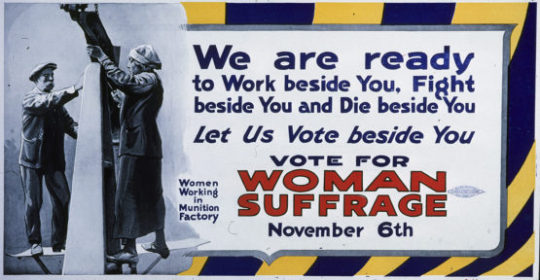
1917 poster for the New York state campaign for voting rights for women. (Image credit: U.S. Poster Collection, Hoover Institution Library & Archives)
The franchise did not happen overnight, but through decades of campaigning by women’s suffragists. What makes constitutional change, especially the franchise, so challenging? What resistance and obstacles did these activists encounter?
The Supreme Court held, in the Minor v. Happersett case, in 1874, that the Constitution did not prohibit restricting the franchise to men. What made formal constitutional change hard to accomplish was, in part, that the existing electorate in most of the country was entirely male and the mechanism for formally amending the Constitution runs through existing legislative bodies – many of which were entirely, or predominantly, elected by men. What made changes in constitutional interpretation – for example, in interpreting the equal protection clause – so difficult, was that public attitudes often treated women as less rational and independent than men, and therefore less qualified to participate in public affairs.
What might activists today learn from the suffrage movement?
Sometimes, activists don’t recognize that times of crisis can be opportunities to make real progress. The suffrage movement seemed stalled by the first decade of the 20th century. But World War I changed the dynamic and ultimately strengthened the suffrage movement. The industrial demands of modern war meant that women moved into the labor force and contributed to the war effort on the home front. In 1918, President Wilson, who had ignored suffrage completely in his 1916 address to Congress, gave an address in which he supported suffrage “as a war measure,” noting that the war could not be fought effectively without women’s participation.
Moreover, the United States claimed it had gone to war to make the world “safe for democracy.” Suffragists conscripted rhetorical claims advanced in favor of the war, and pointed to women’s key role on the home front, to bolster their arguments in favor of domestic expansion of voting rights, For example, in her article about suffrage and the 19th Amendment, Justice O’Connor reports that “when the new Russian Republic extended the vote to women following its revolution, suffragists taunted President Wilson with the lack of similar progress in the United States.”
“Constitutional change comes about through people … pressing for their rights.”
—PAMELA S. KARLAN
The Kenneth and Harle Montgomery Professor of Public Interest Law
What did the 19th Amendment fail to accomplish, and what can be done to continue to promote the franchise among voters?
In narrow terms, the 19th Amendment was stunningly successful, especially in comparison to the 15th Amendment, which in essentially identical language forbid denying or abridging the right to vote on account of race or color. White women throughout the U.S. have faced very few legal barriers to voting since the amendment’s ratification. By contrast, racial discrimination in voting – the form of discrimination prohibited by the 15th Amendment – persisted in a prevalent and explicit form for essentially a century, essentially denying Black women in the South the right to vote until passage of the Voting Rights Act of 1965. And even today we continue to see all kinds of barriers to full and equal participation by minority citizens.
The United States has a decentralized, politicized system for regulating the franchise that stands in sharp contrast to most other developed democracies. We need to enact laws with real teeth in them that enable every citizen to register, to cast a ballot and to have that ballot counted.
What do you tell your students about the 19th Amendment?
I often start my Constitutional Law course with two things – a short video of the House of Representatives opening its session by reading the Constitution, in which Rep. John Lewis was invited to read the 13th Amendment, and an excerpted version of the opinion in Minor v. Happersett. This is designed to remind them that there are many methods of interpreting the Constitution – Minor showcases them all – and that constitutional change comes about through people – some of them, like Lewis, younger than my students even – pressing for their rights outside the courts.
Media Contacts
Stephanie Ashe, Stanford Law School: (650) 723-2232, [email protected]
source https://scienceblog.com/517887/how-world-war-i-strengthened-womens-suffrage/
0 notes